Functional styles What is style? What is functional

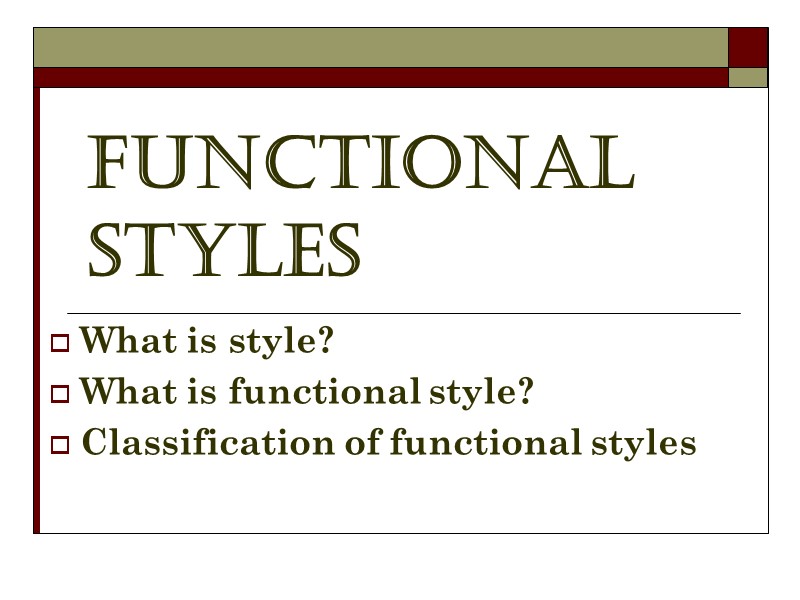
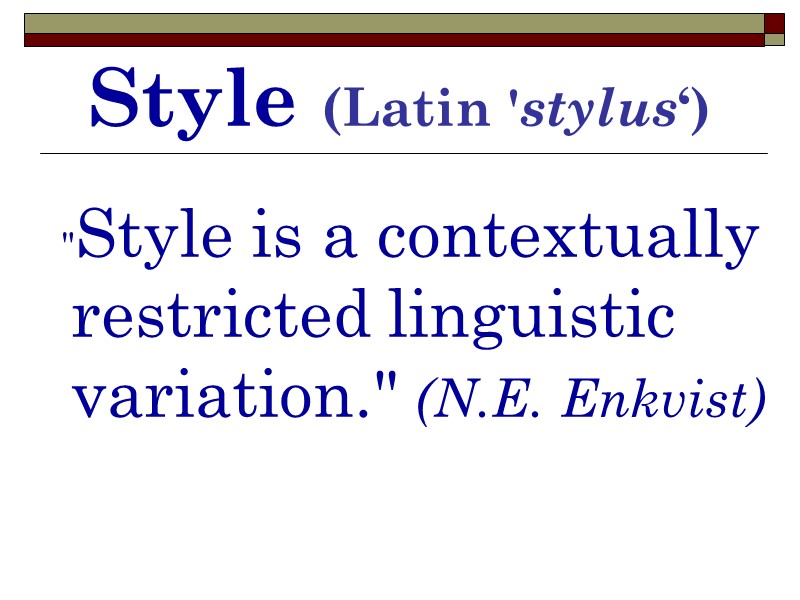
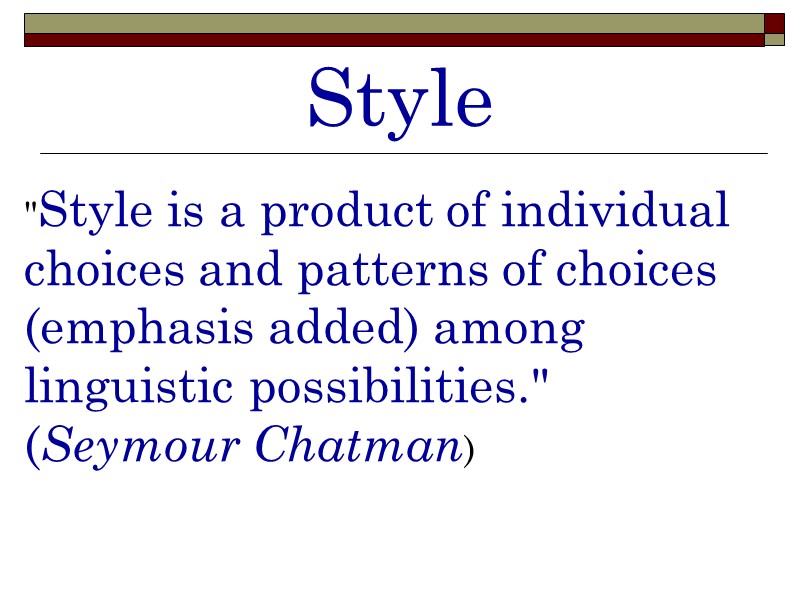
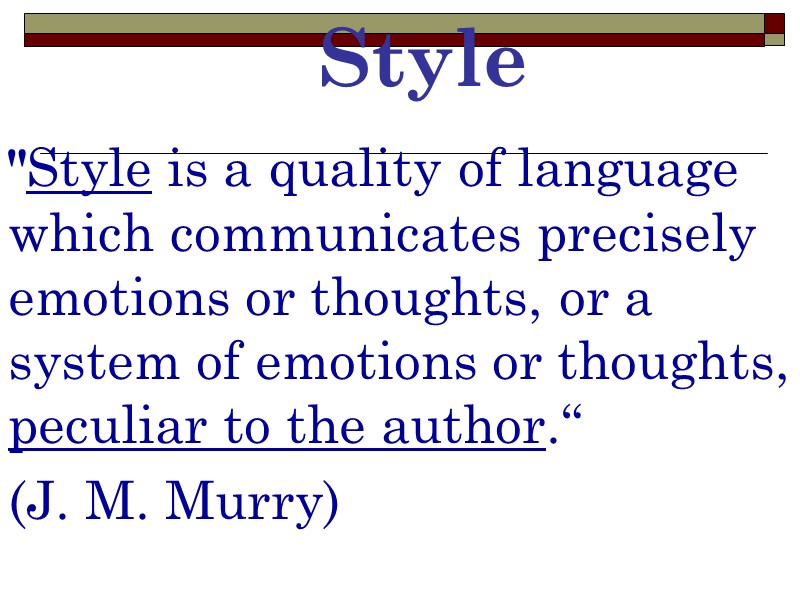
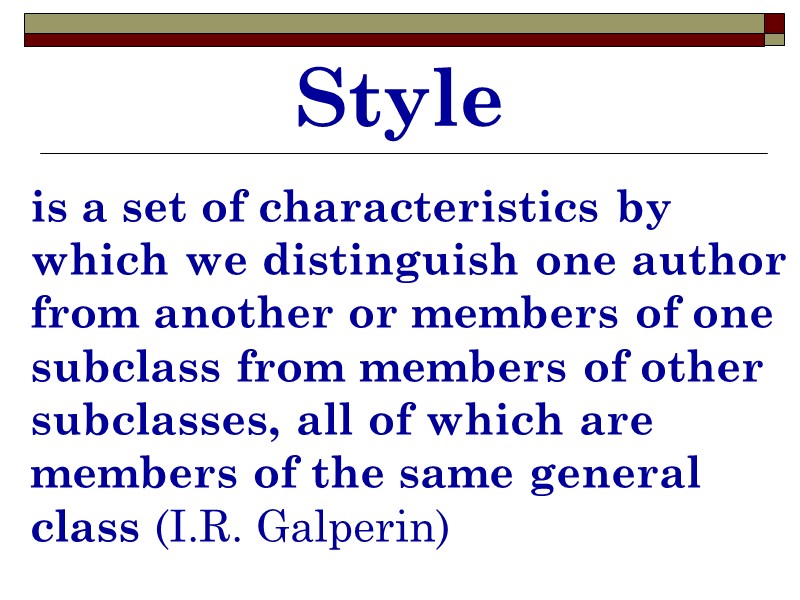
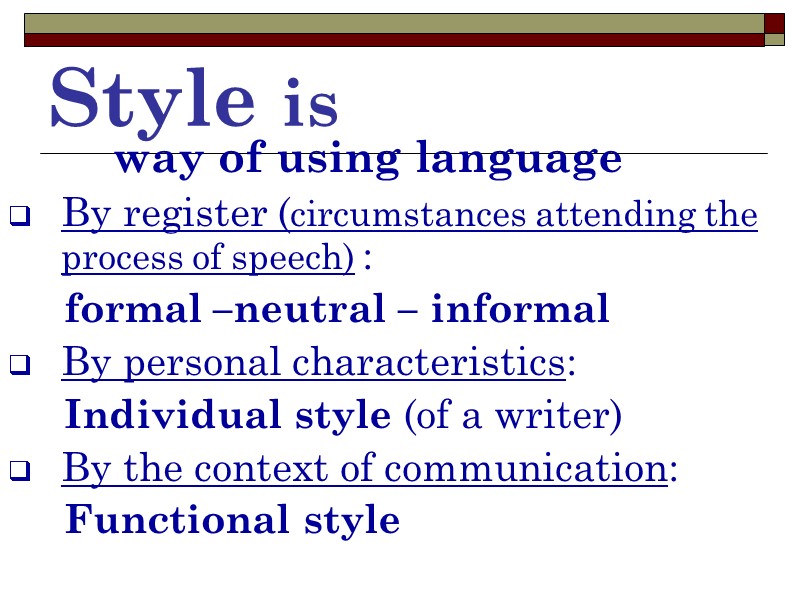
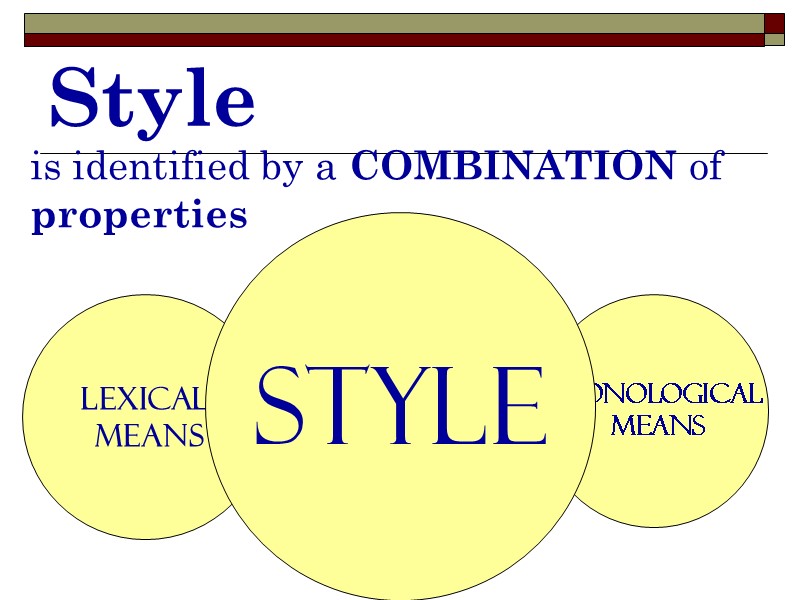
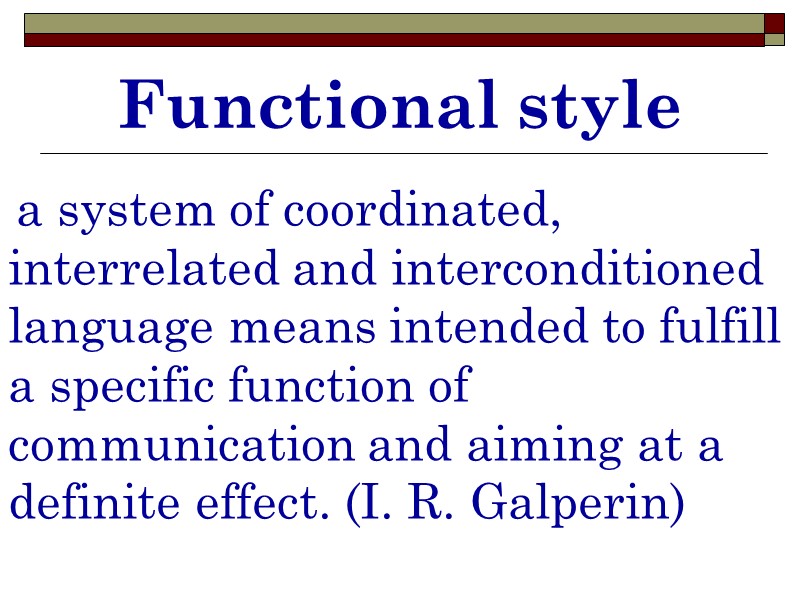
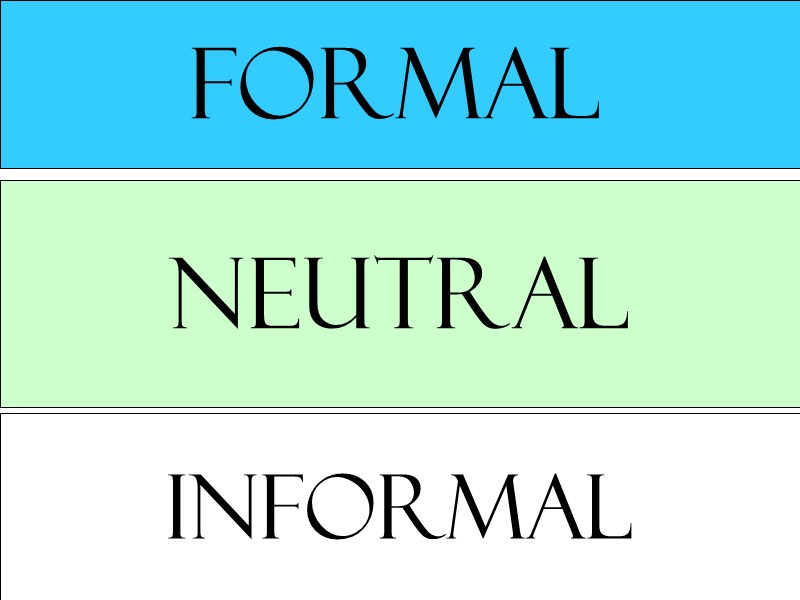
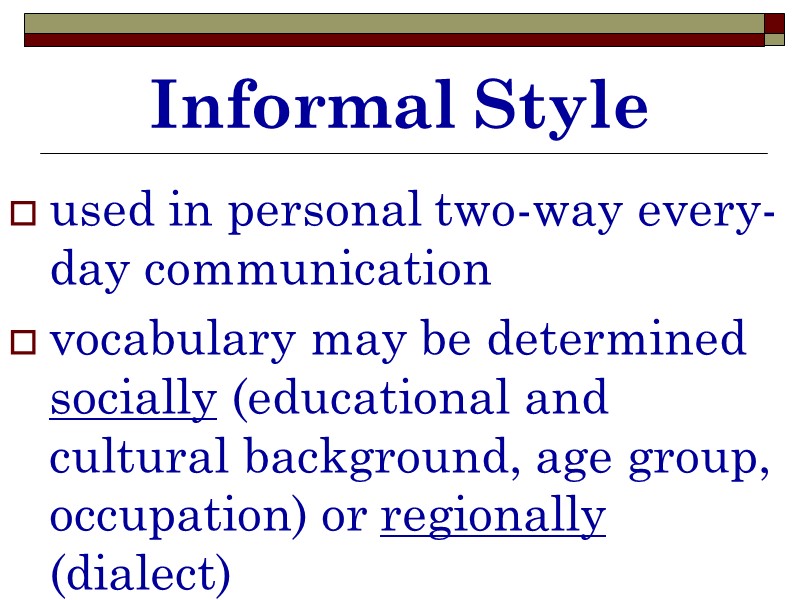
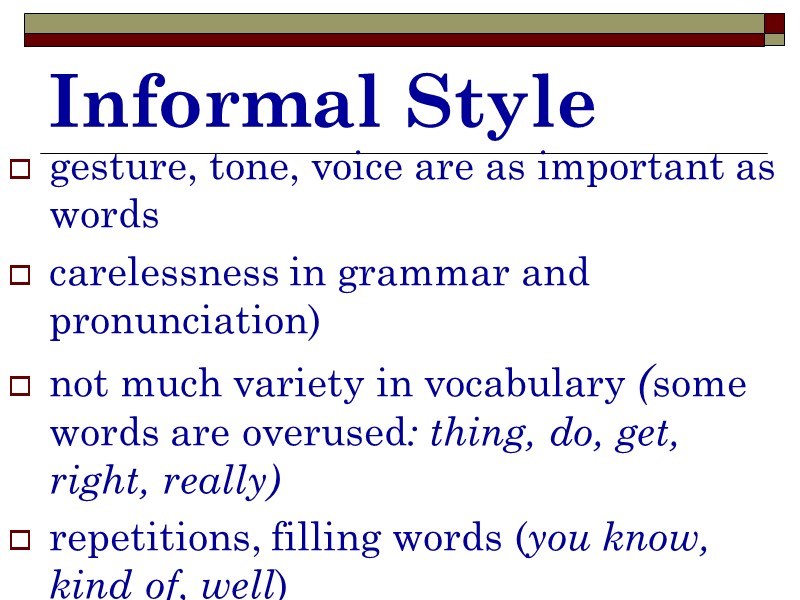
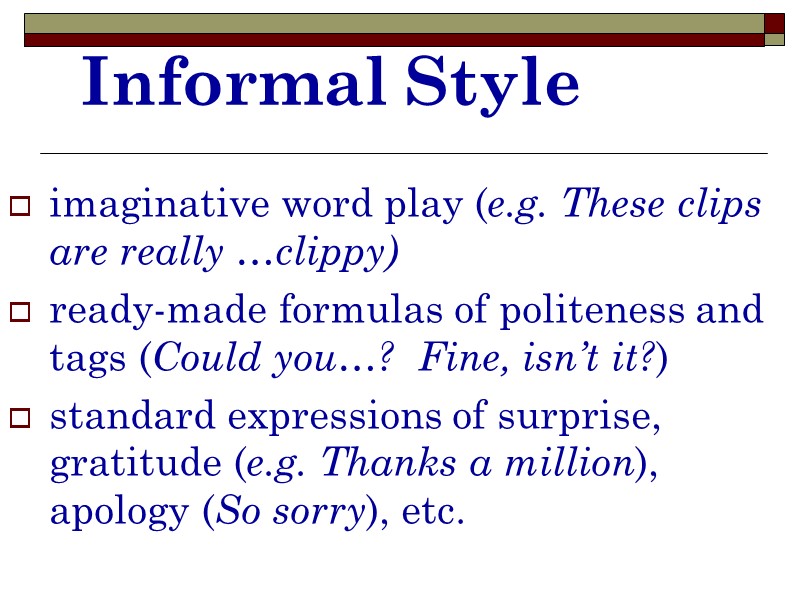
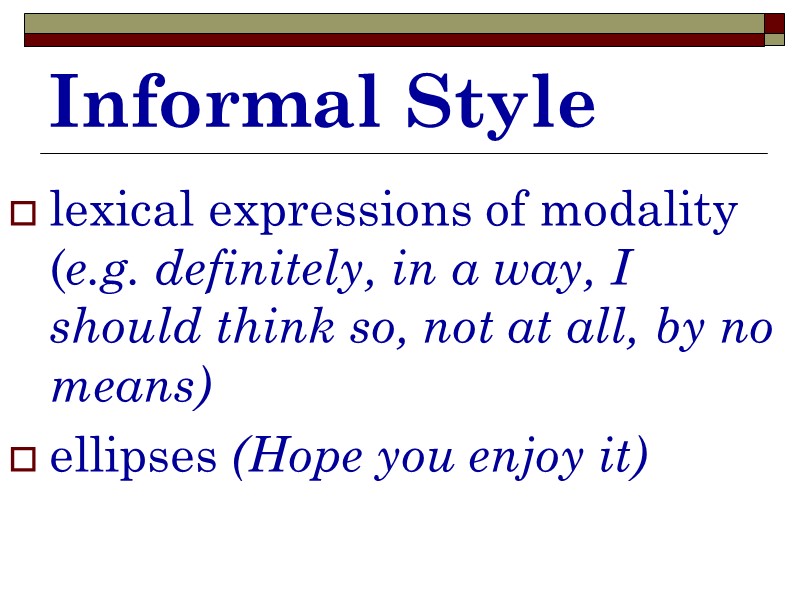
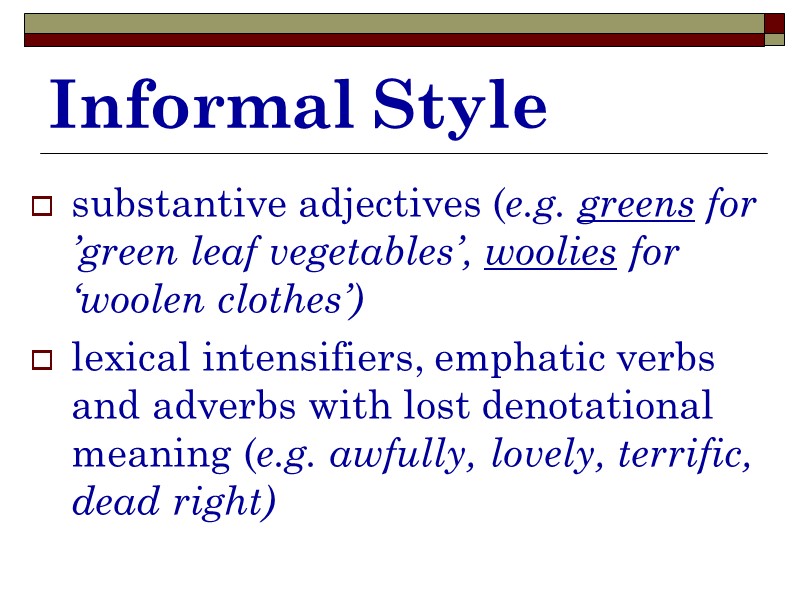
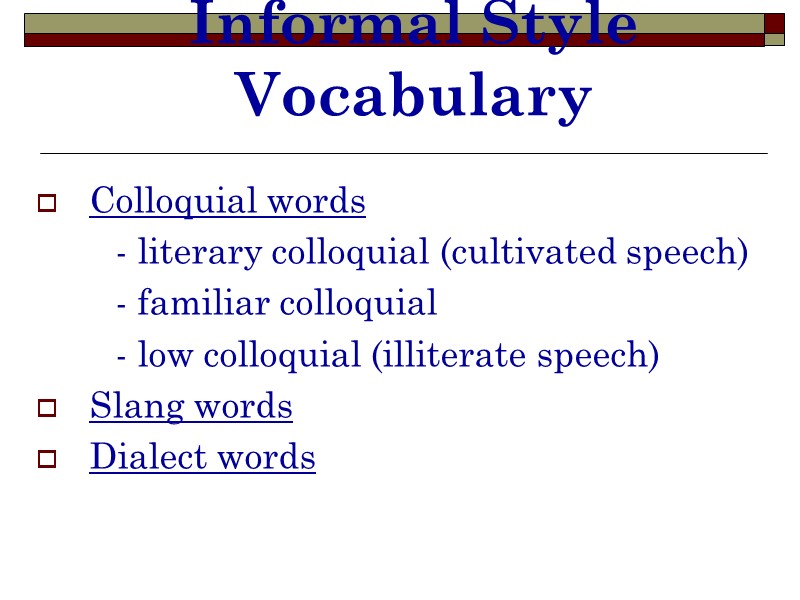
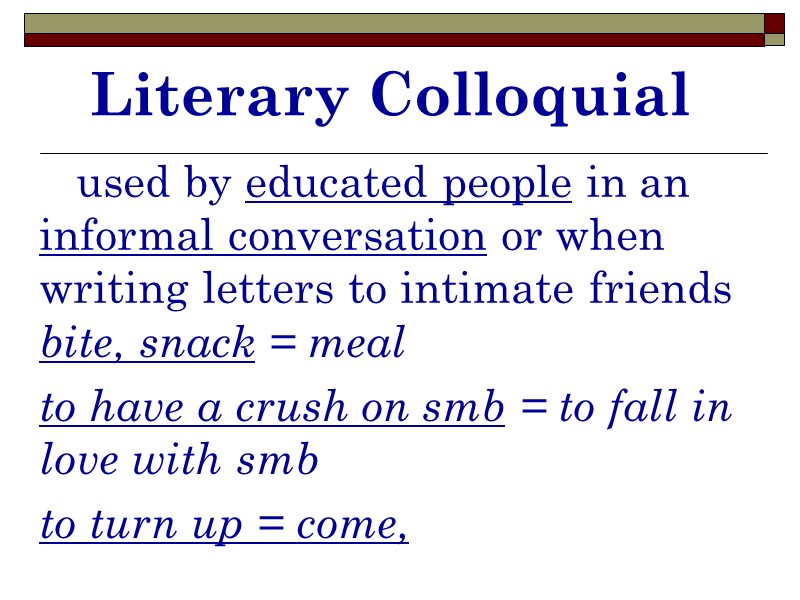
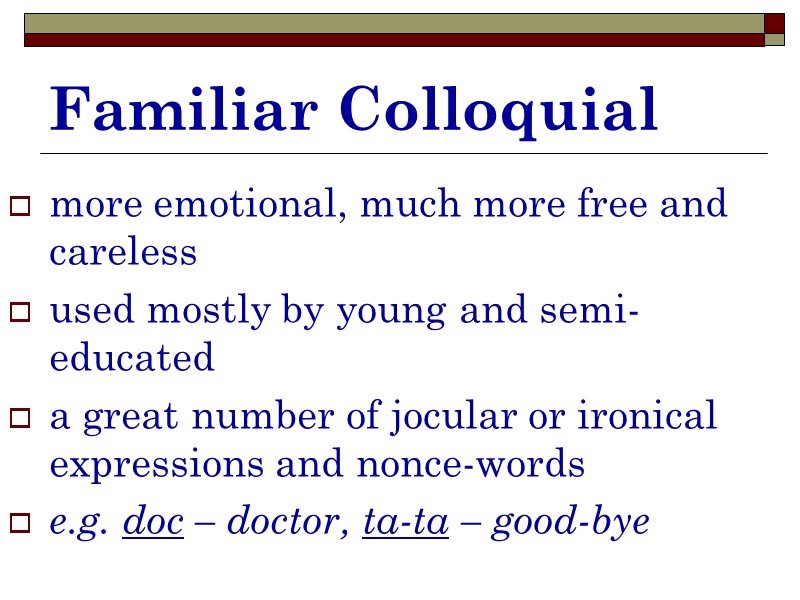
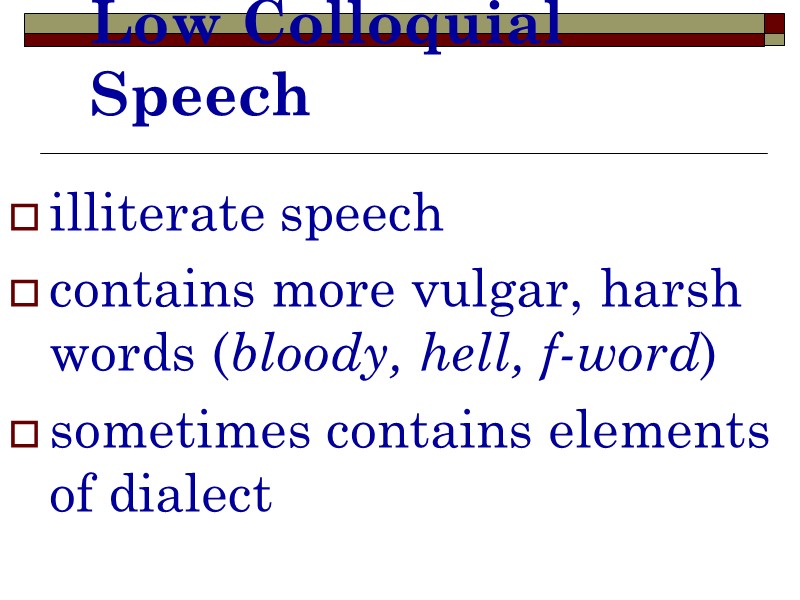
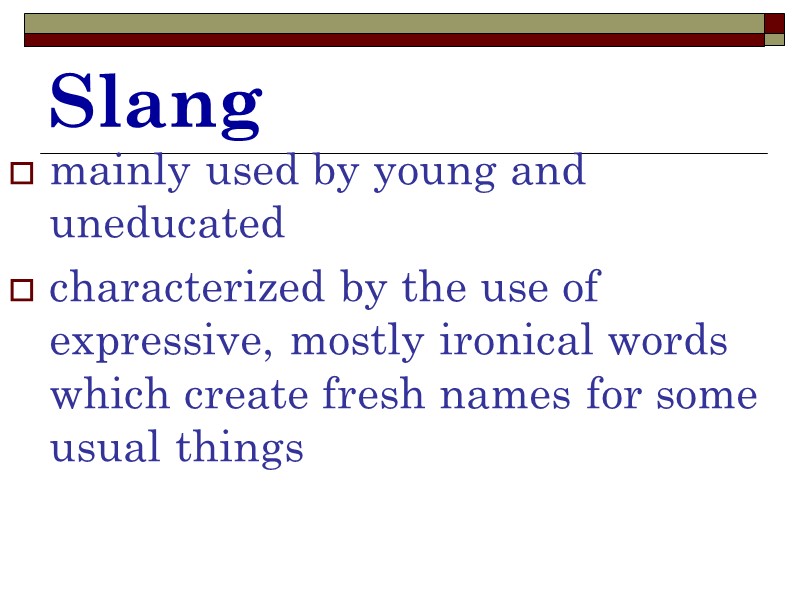
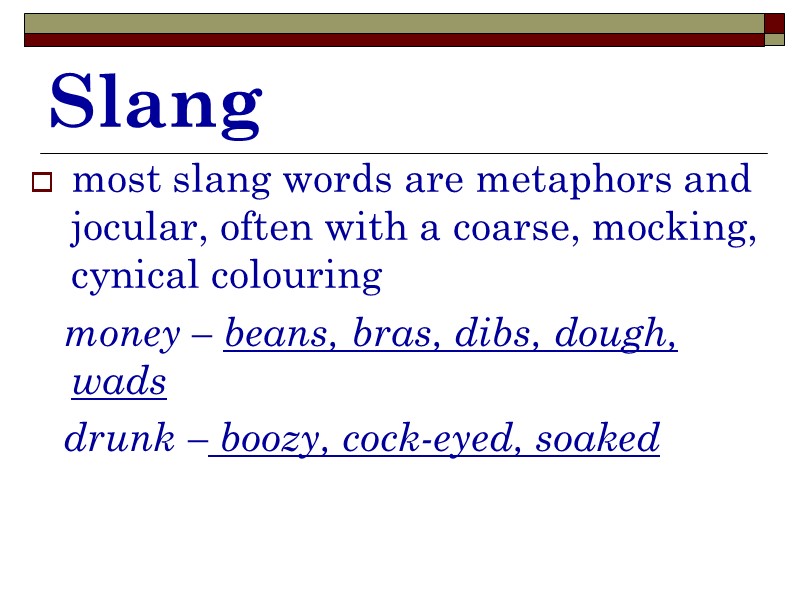
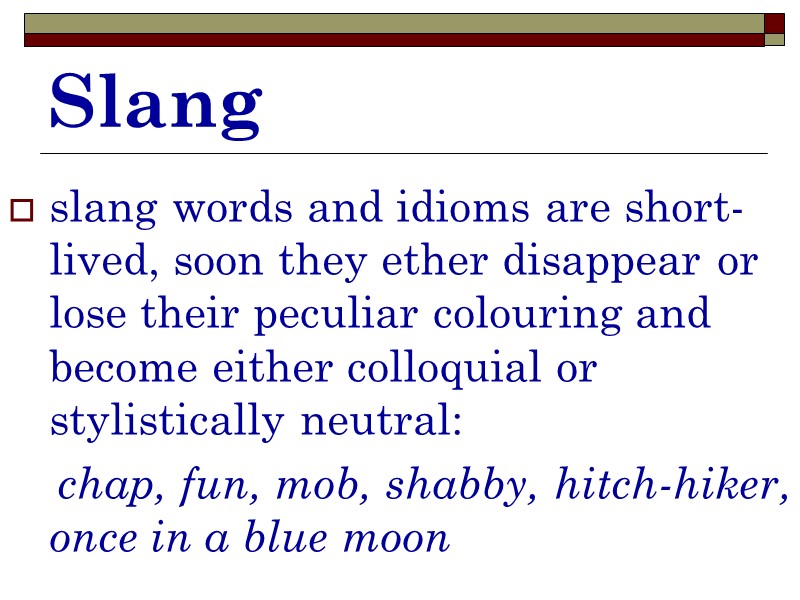
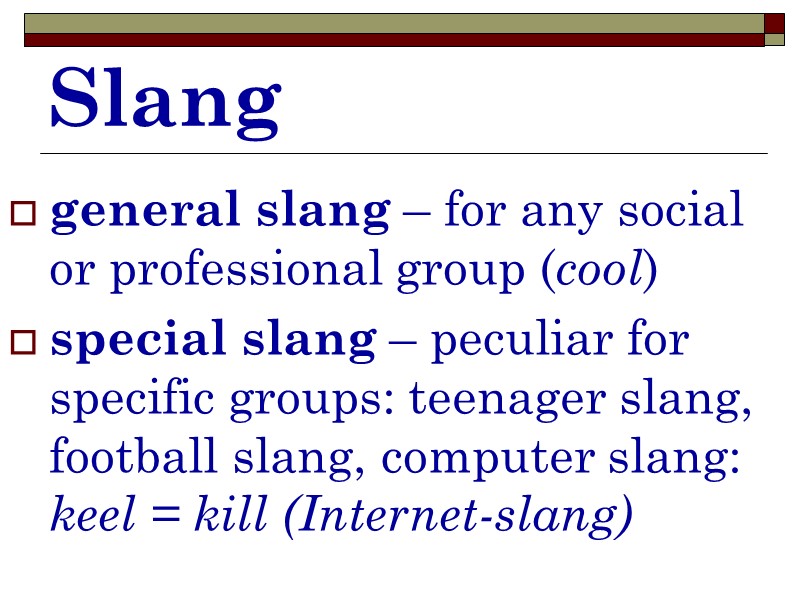
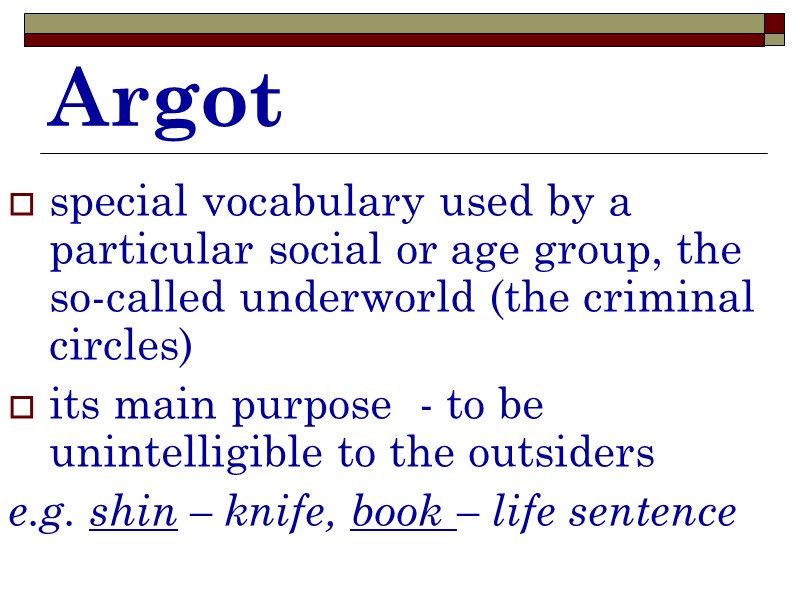
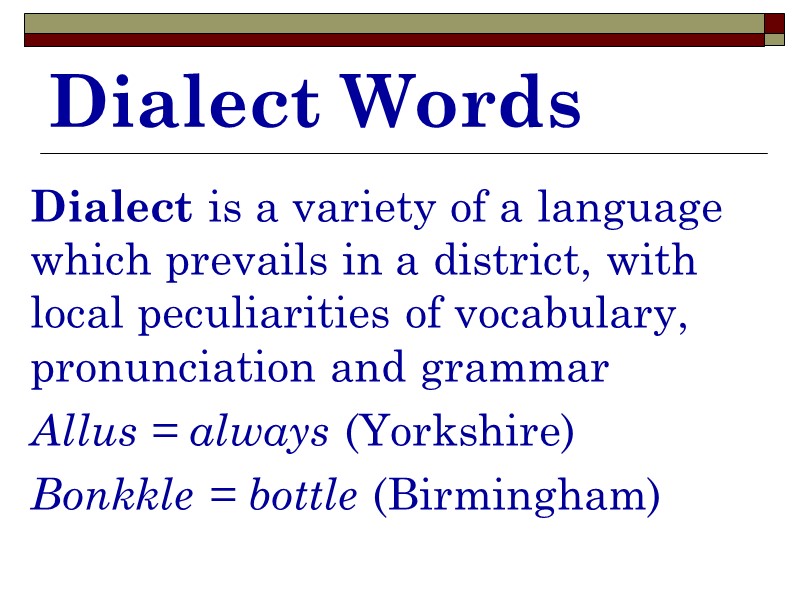
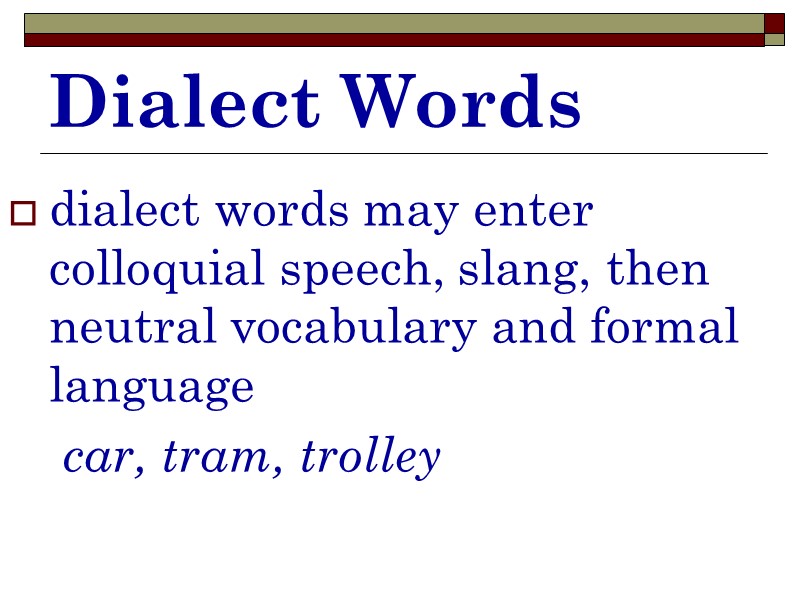
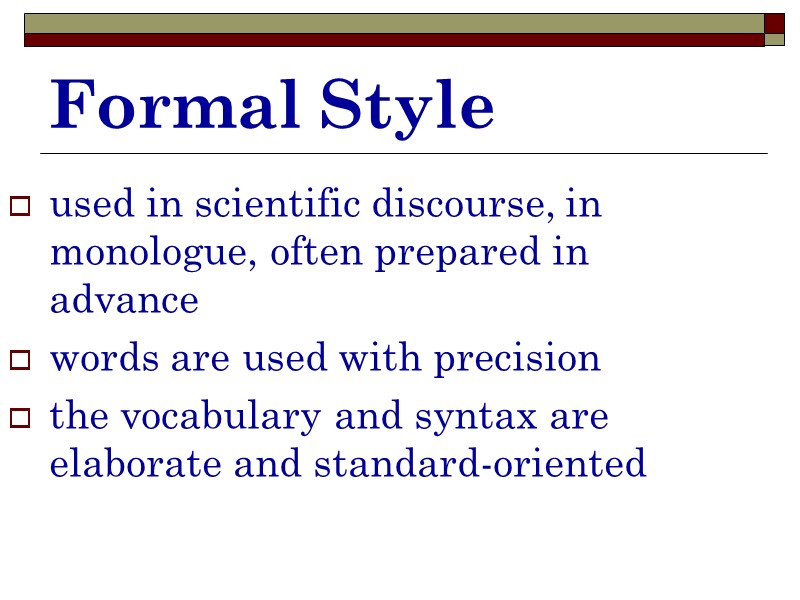
![Formal Style Vocabulary Literary / learned words [lə:nid] Formal Style Vocabulary Literary / learned words [lə:nid]](https://present5.com/presentacii-2/20171213\40906-l1_functional_styles.ppt\40906-l1_functional_styles_27.jpg)
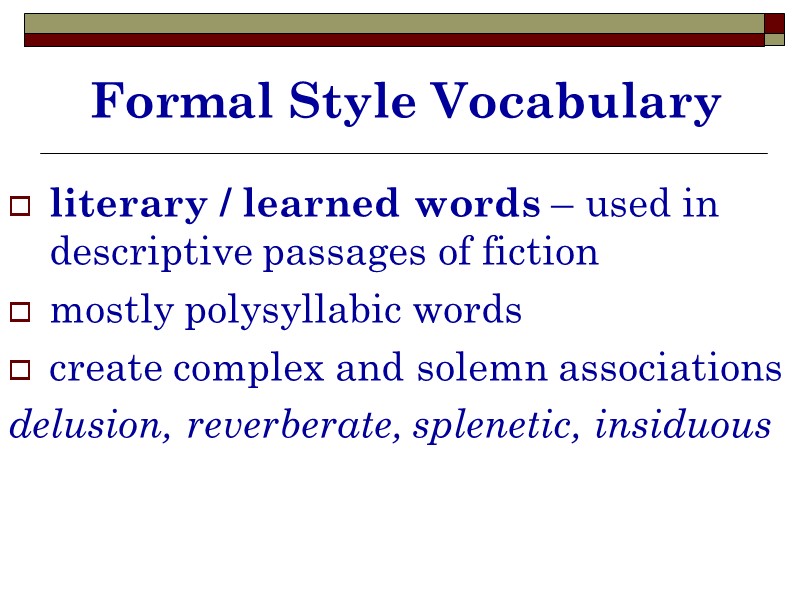
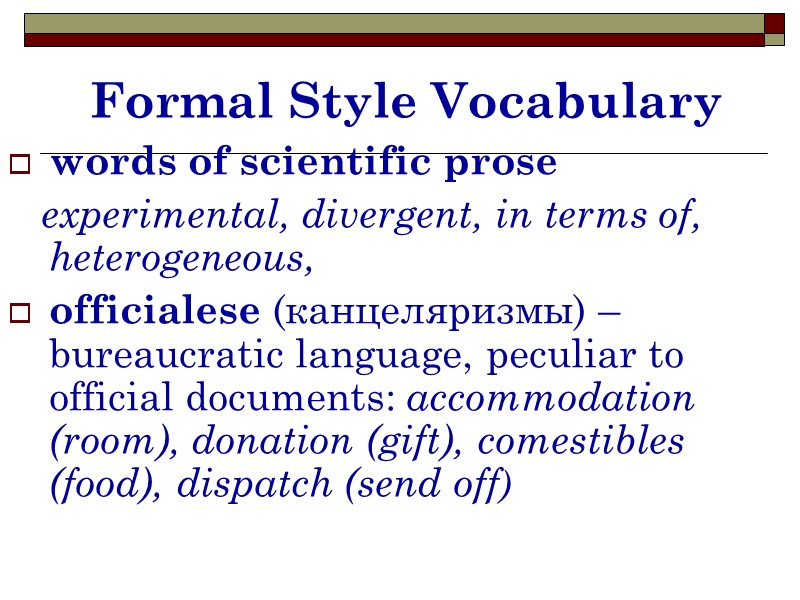
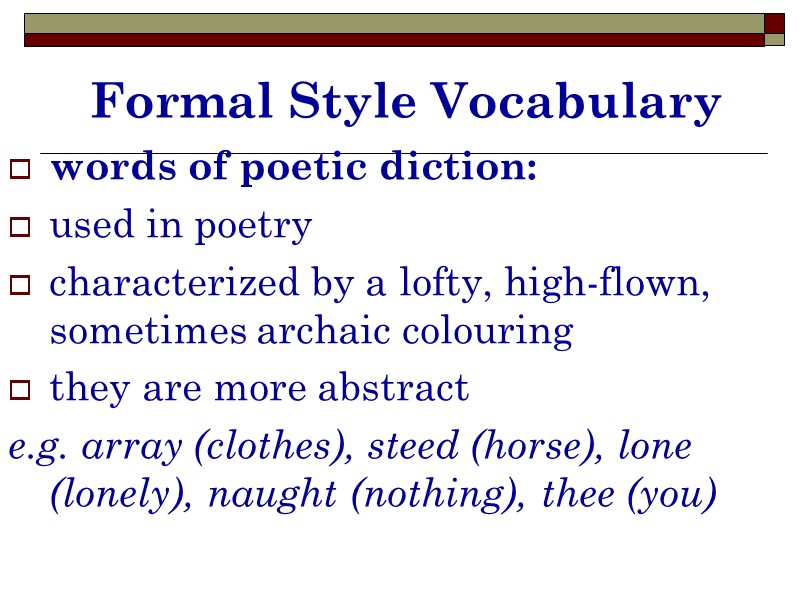
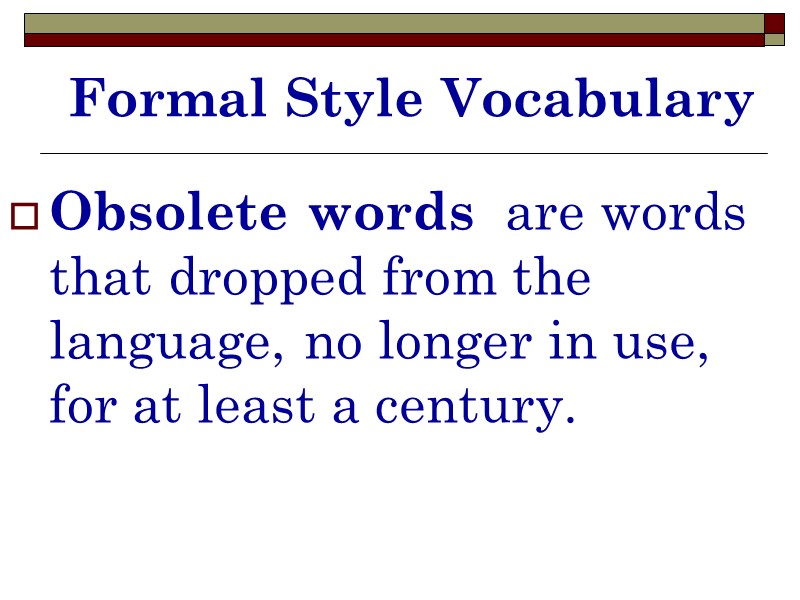
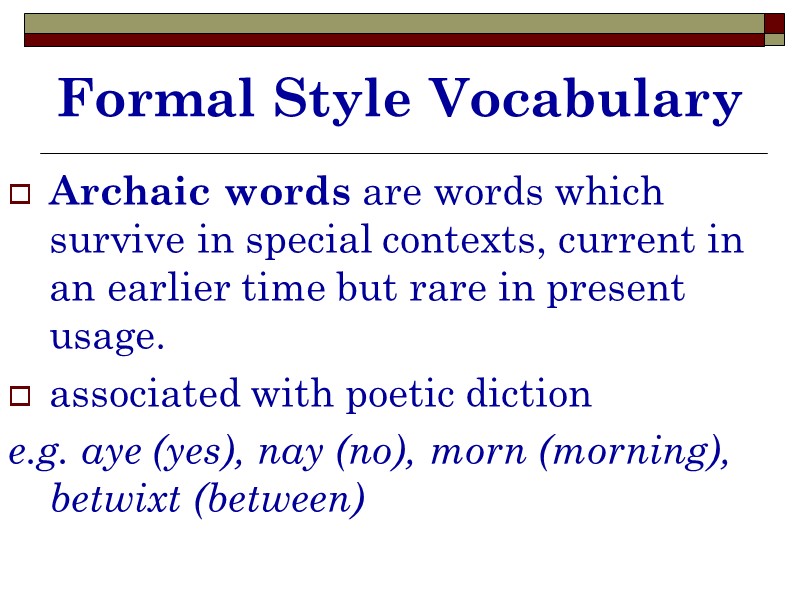
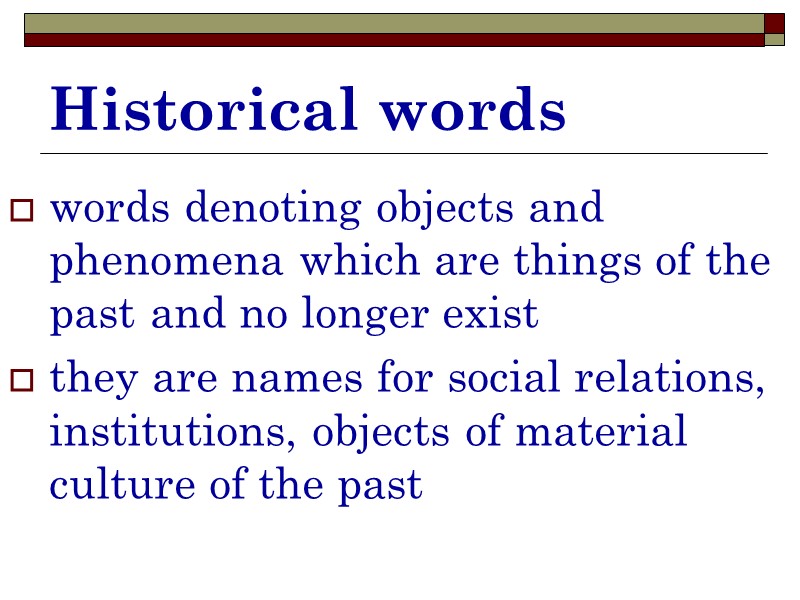
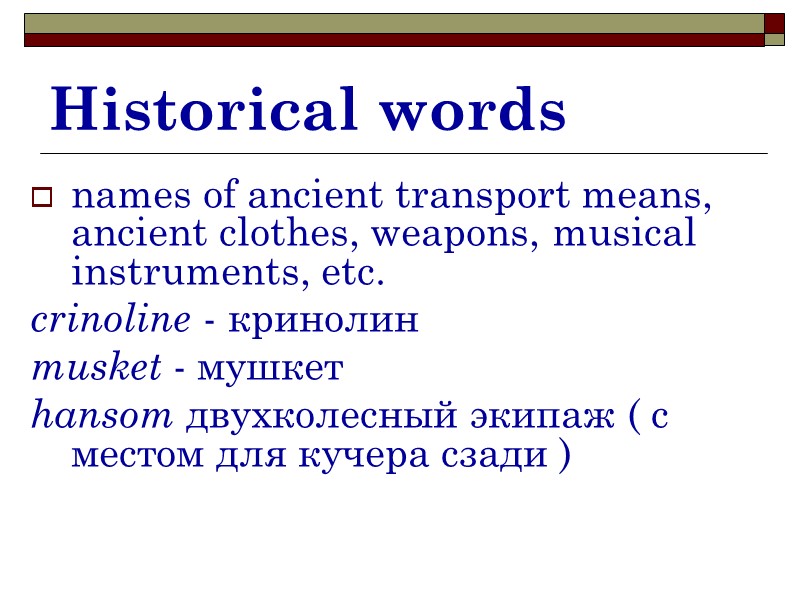
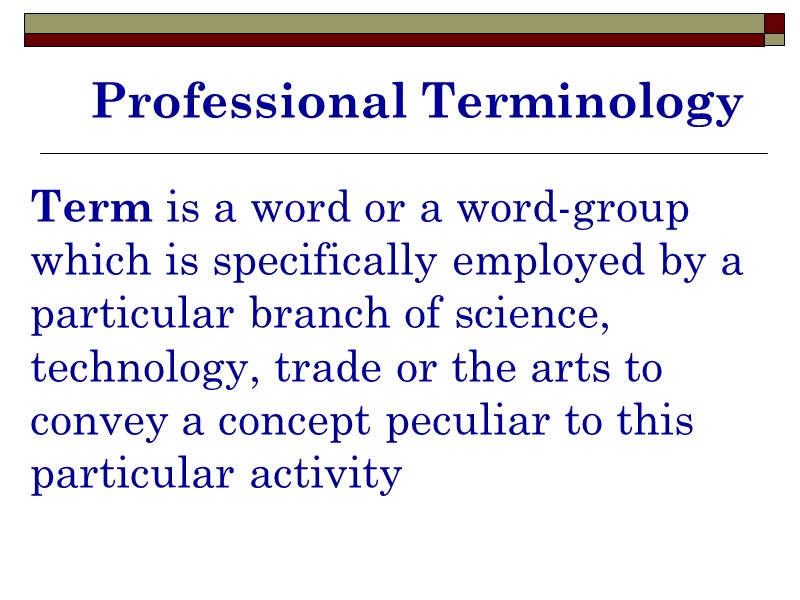
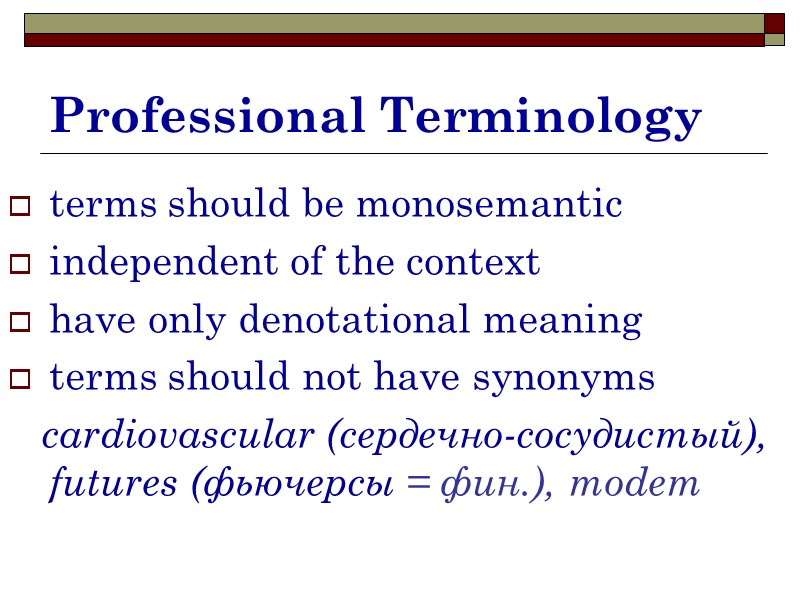
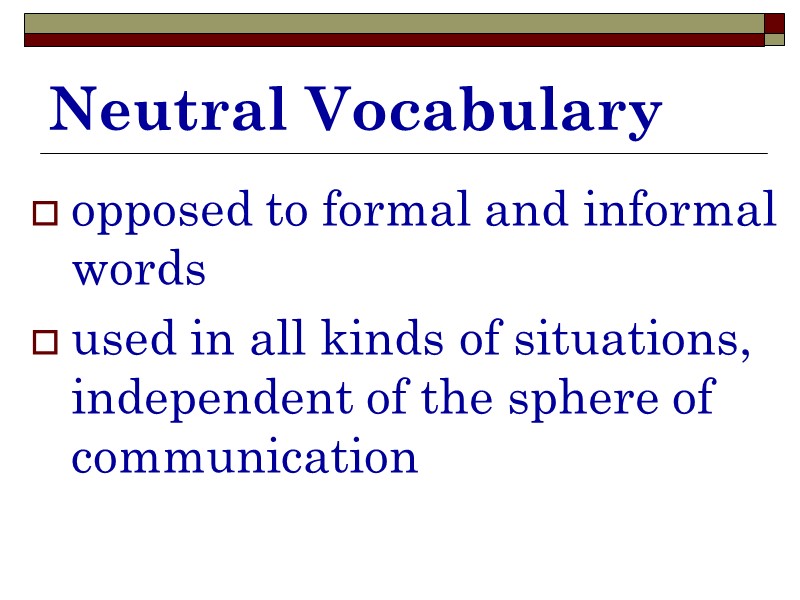
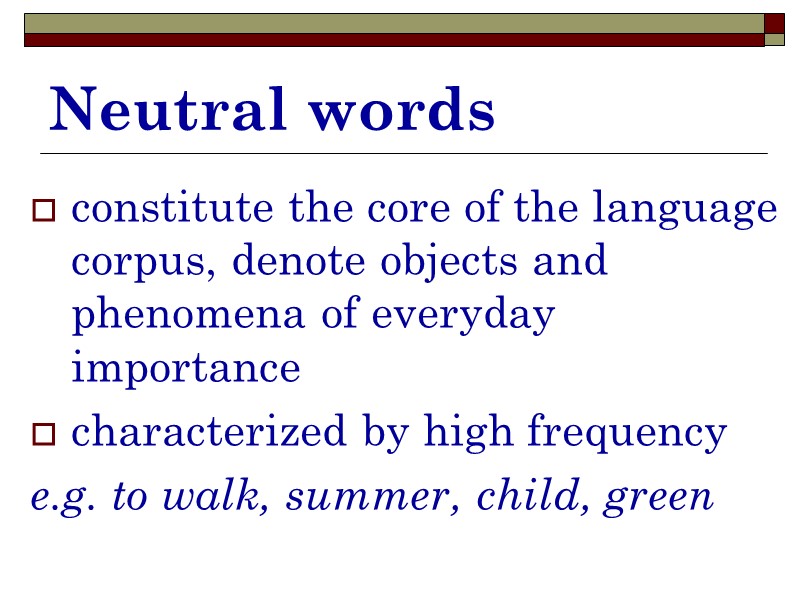
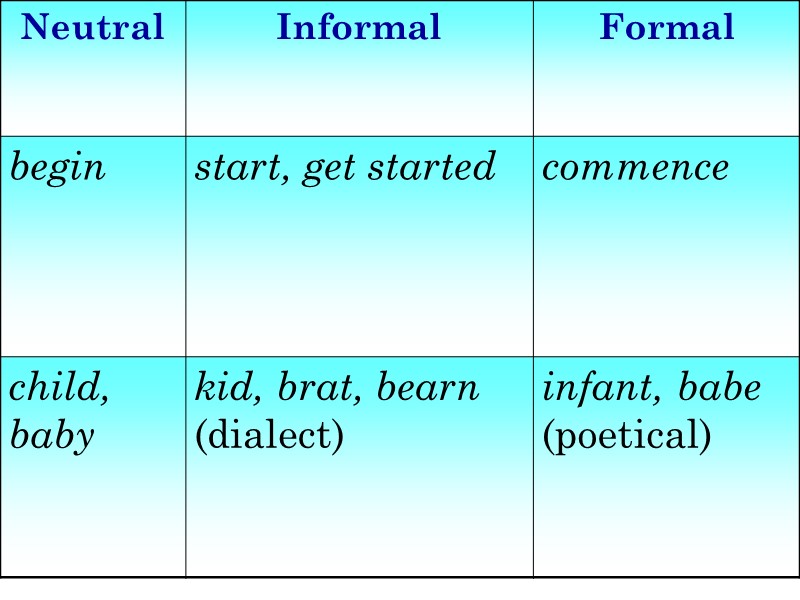
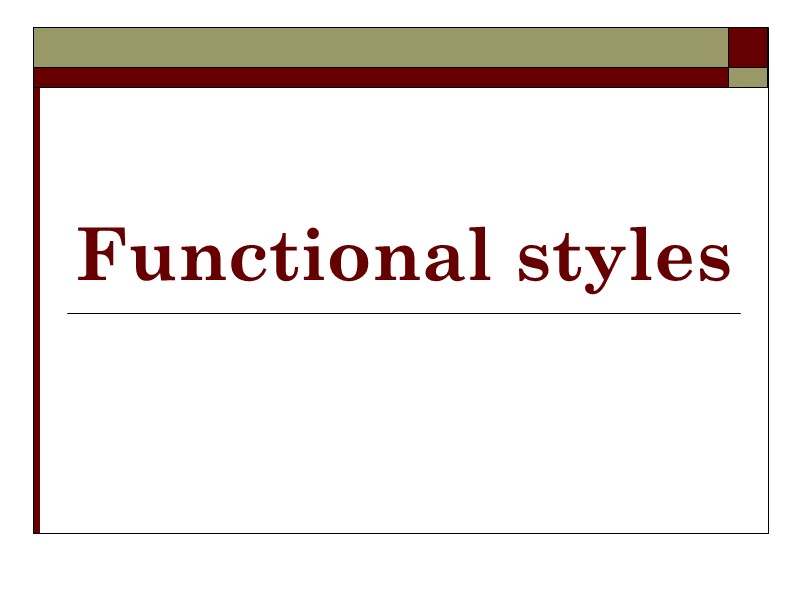
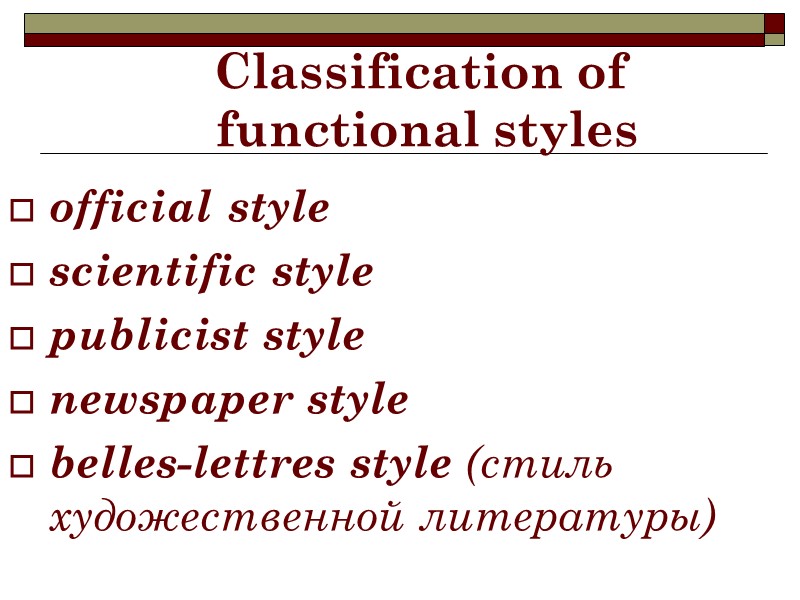
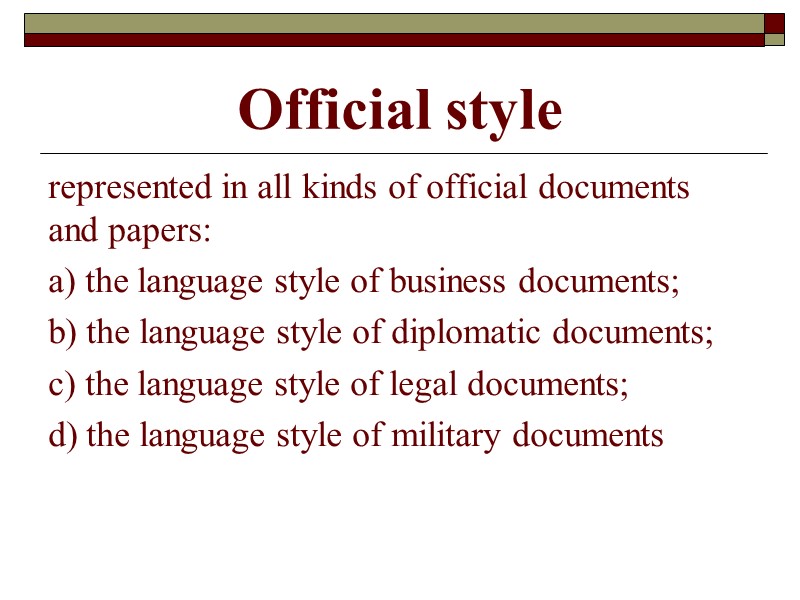
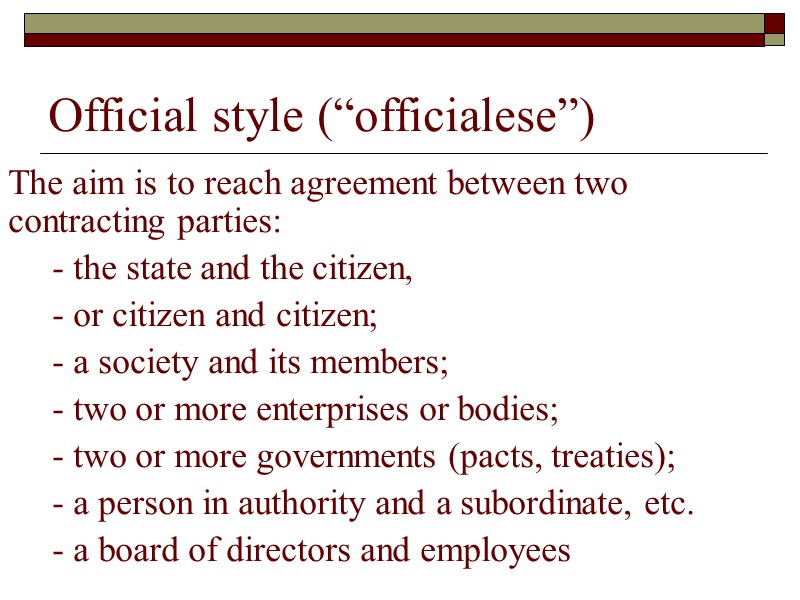
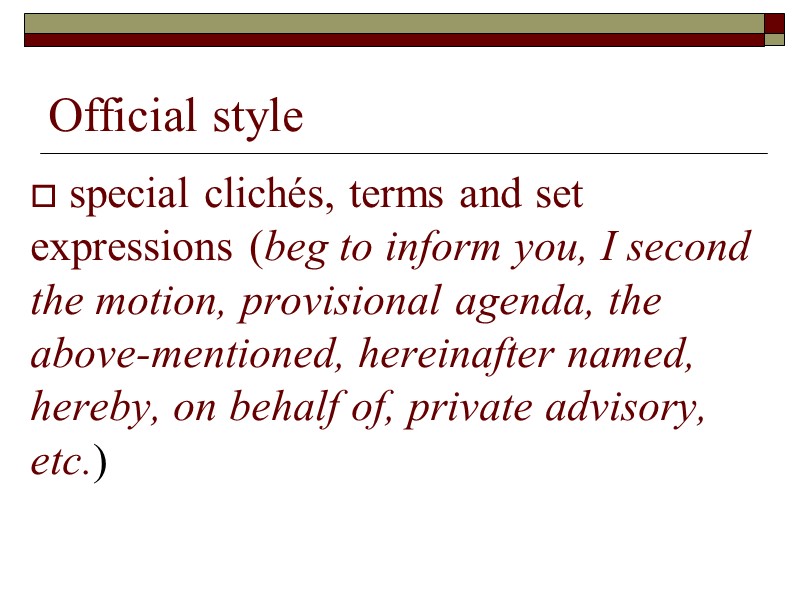
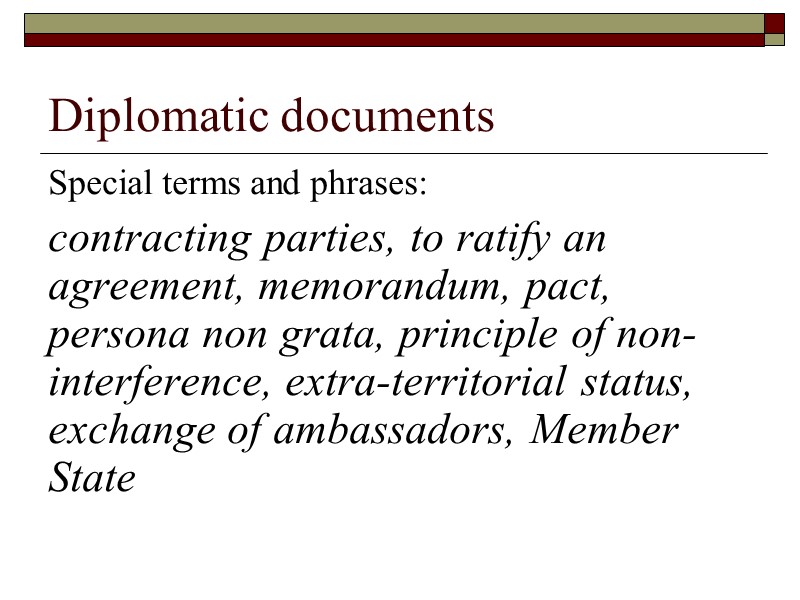
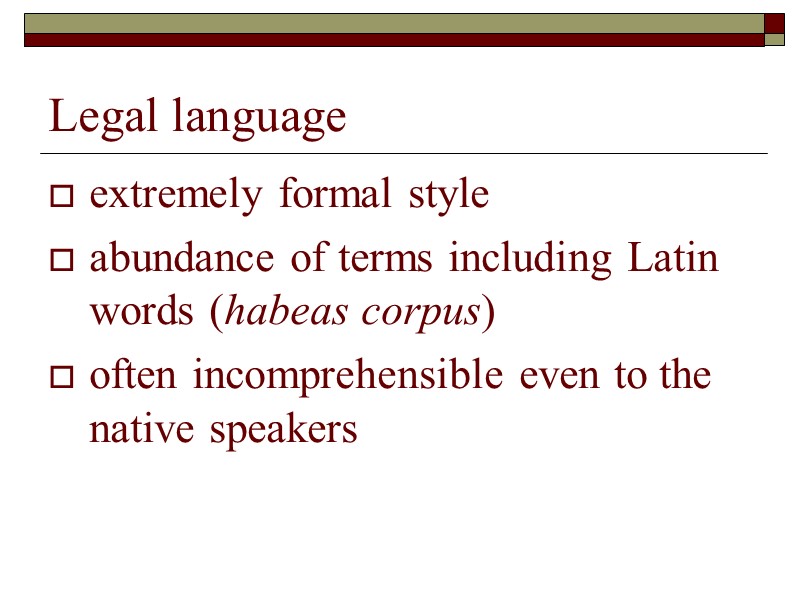
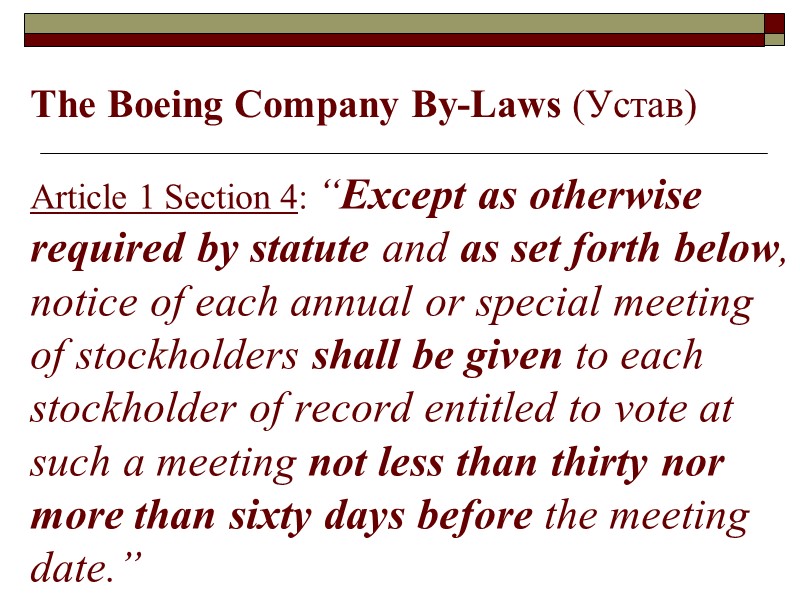
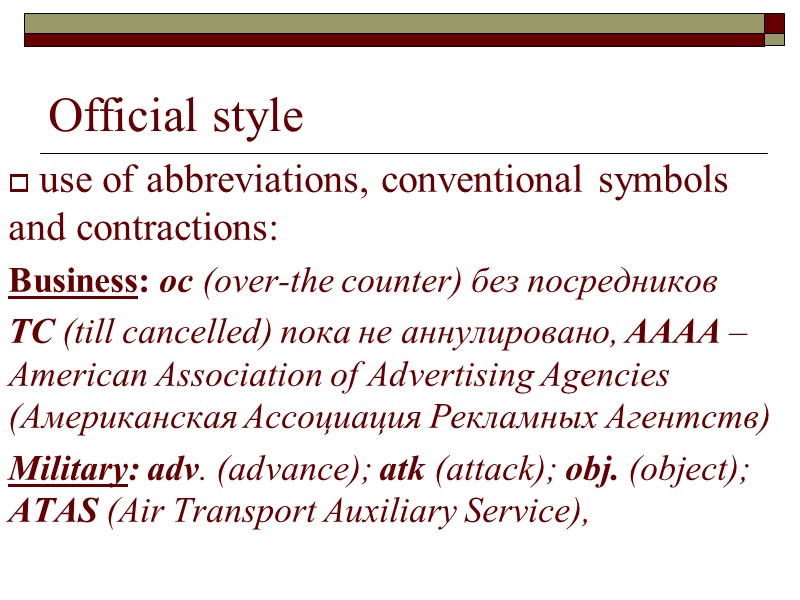
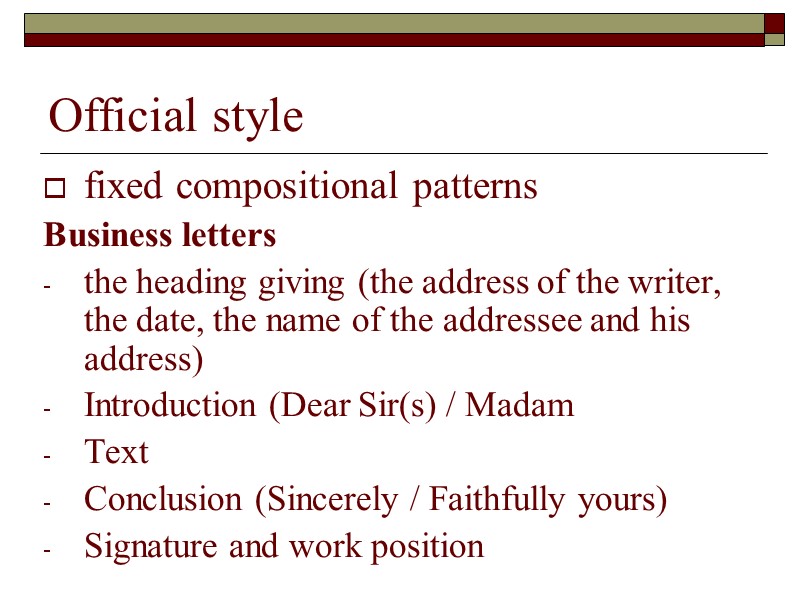
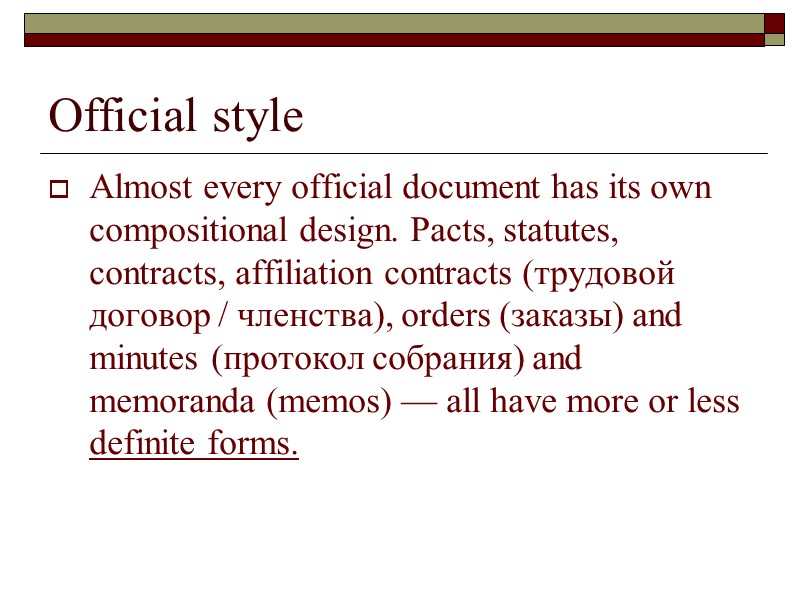
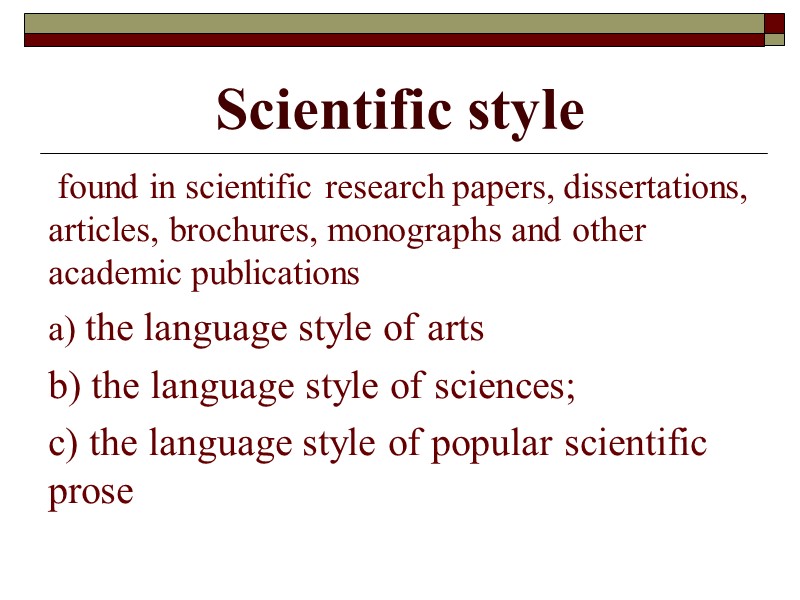
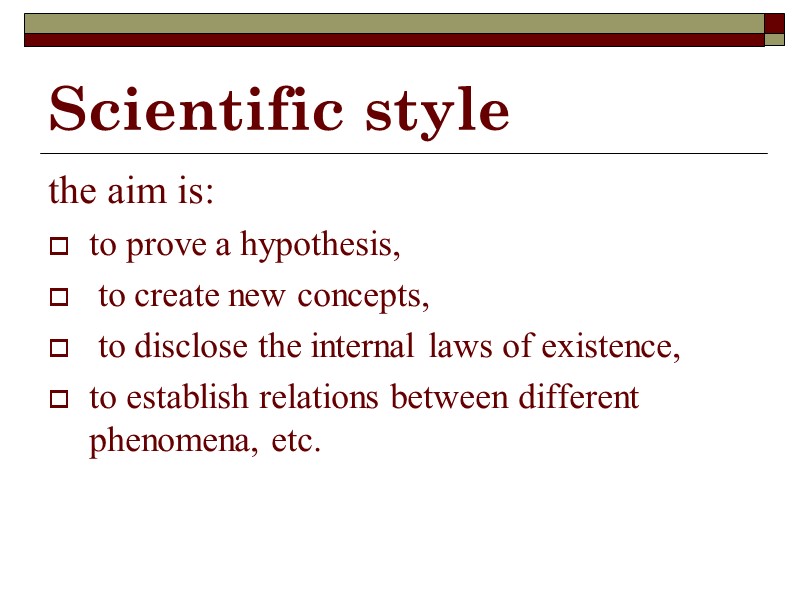
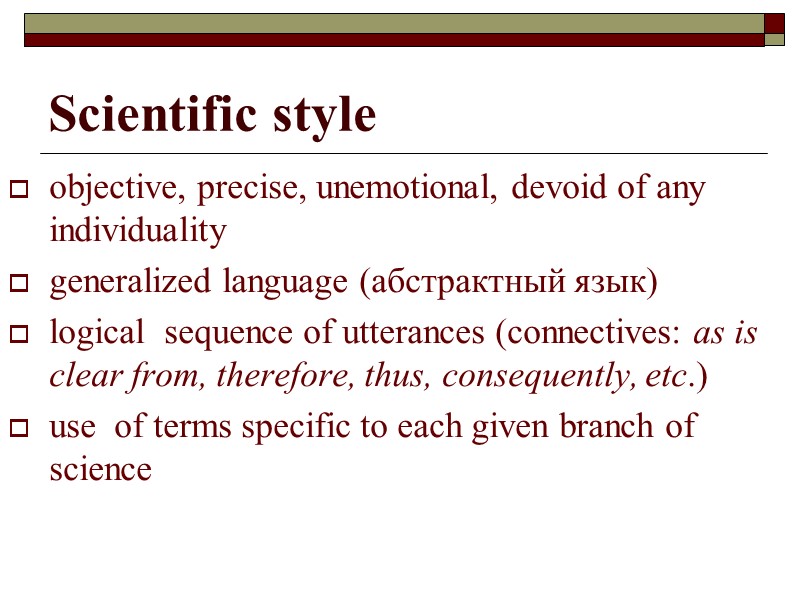
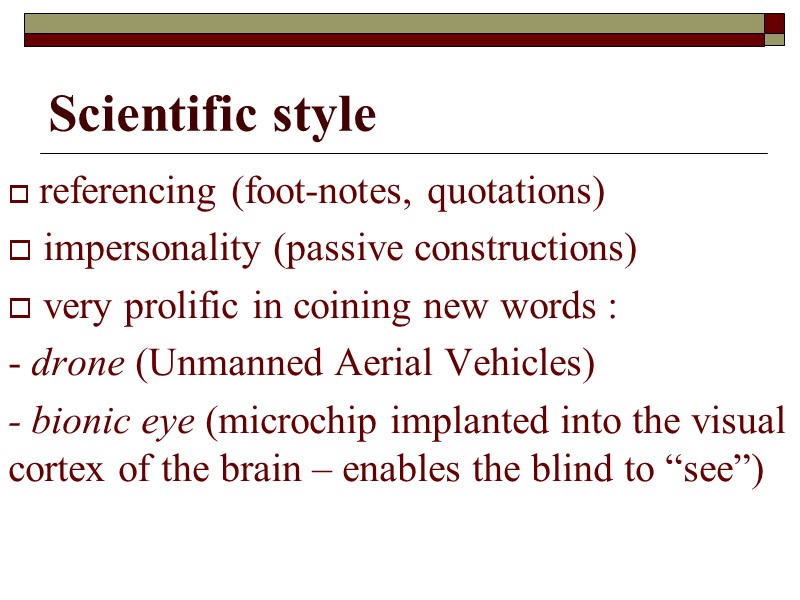
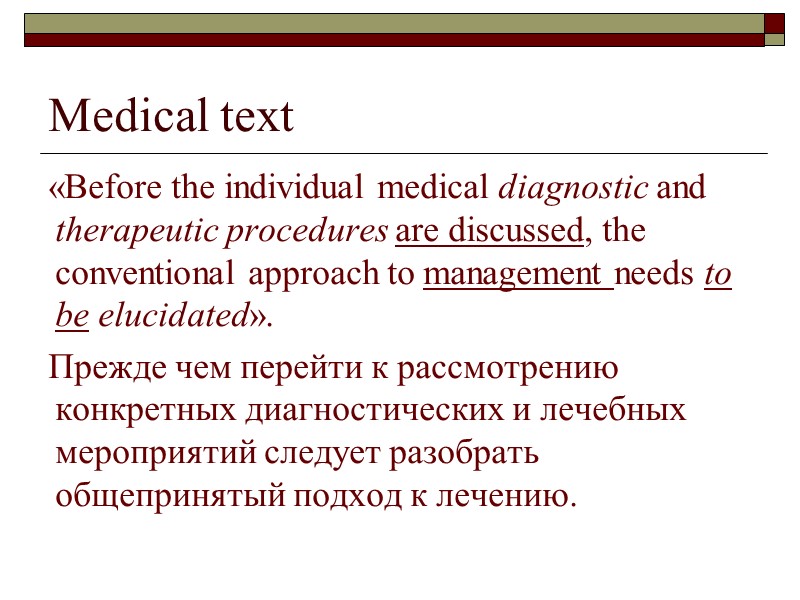
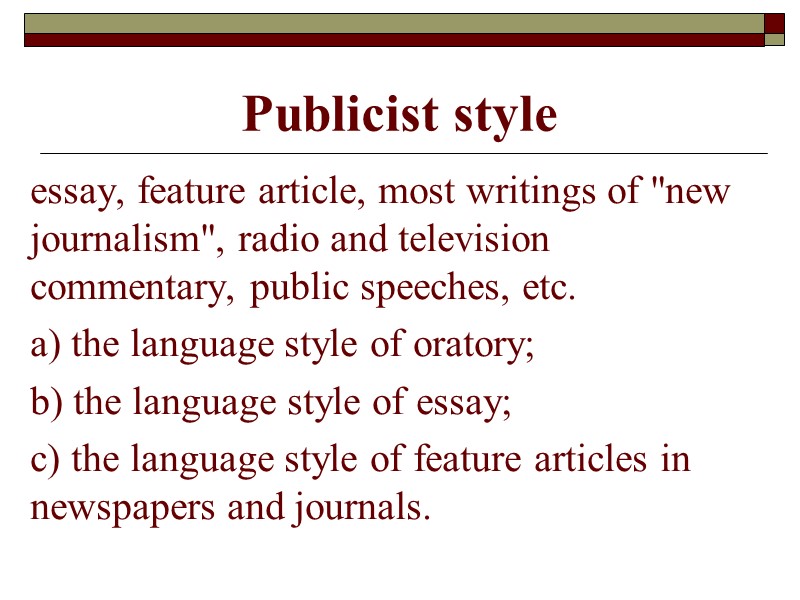
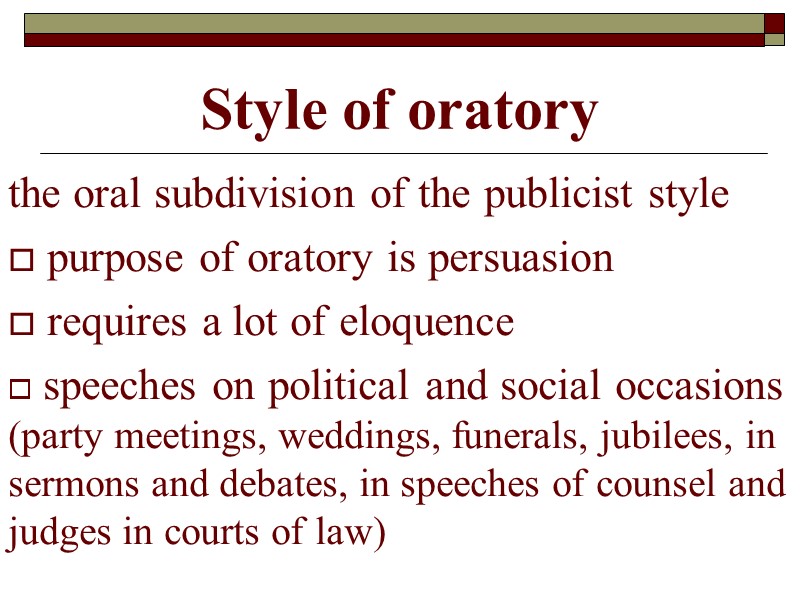
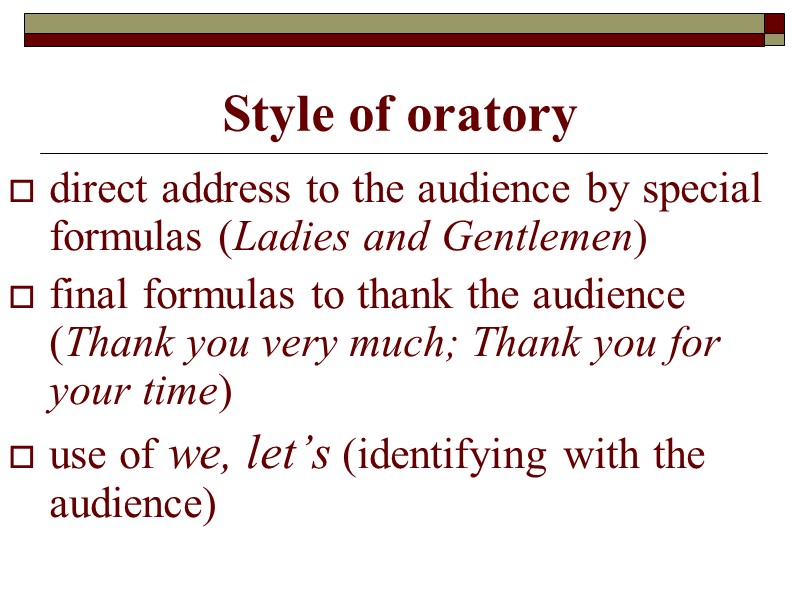
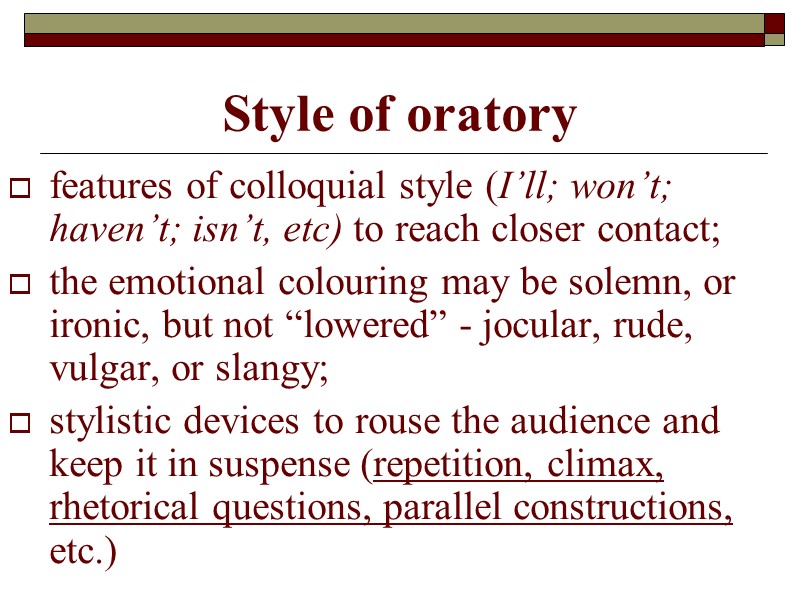
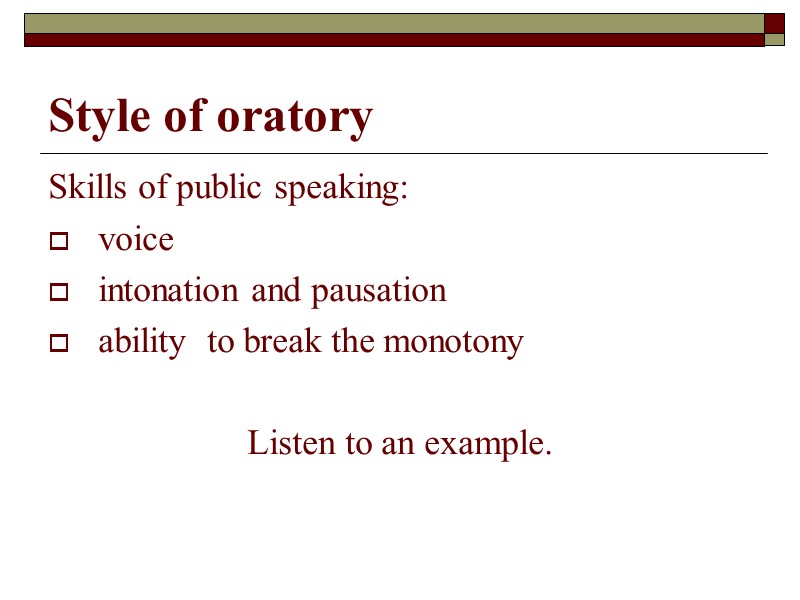
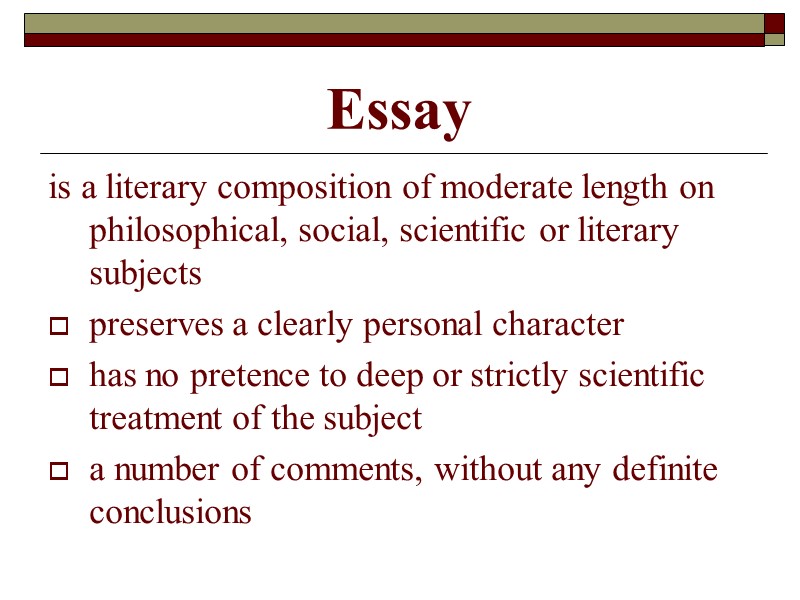
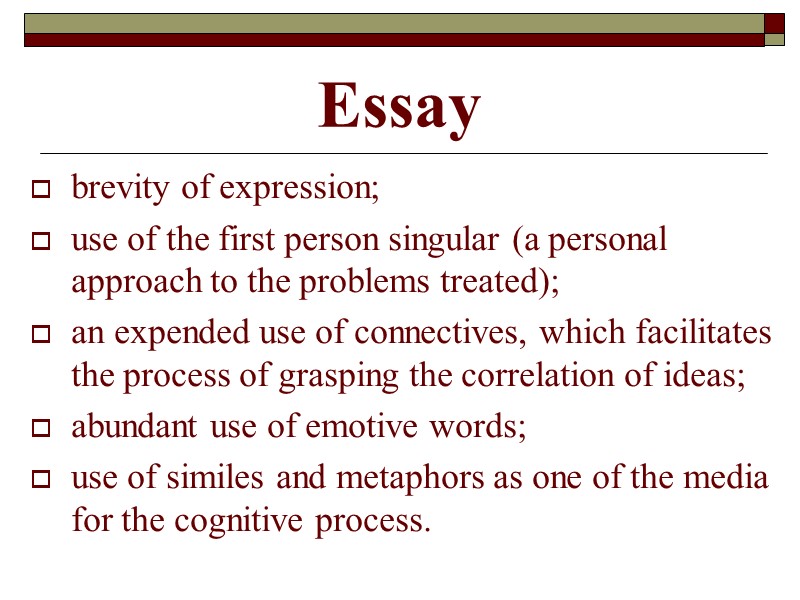
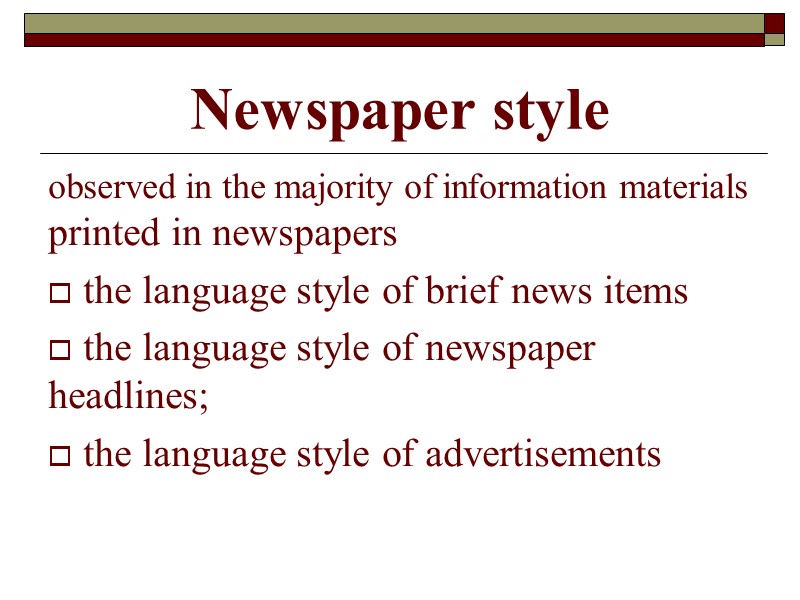
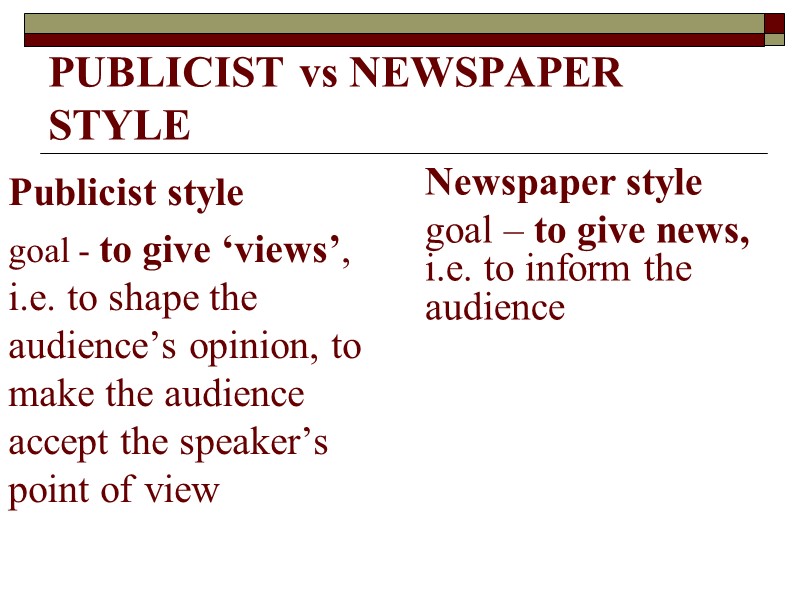
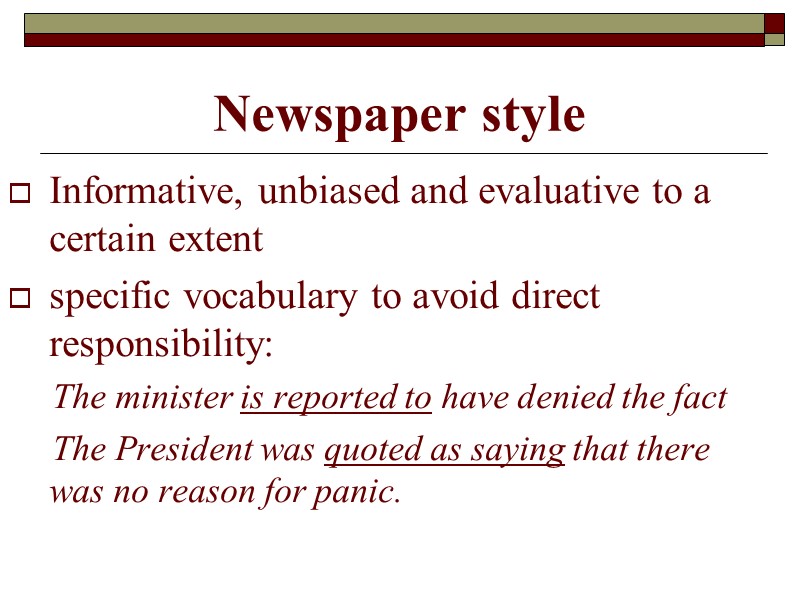
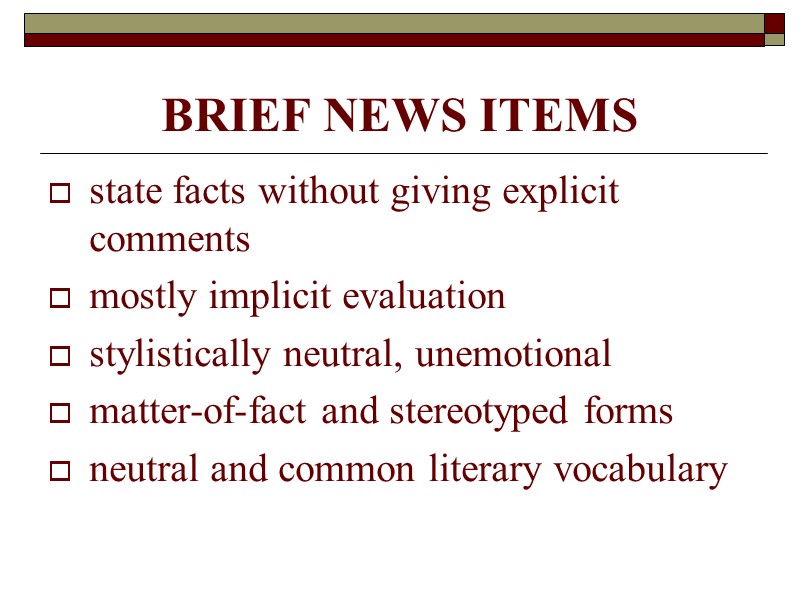
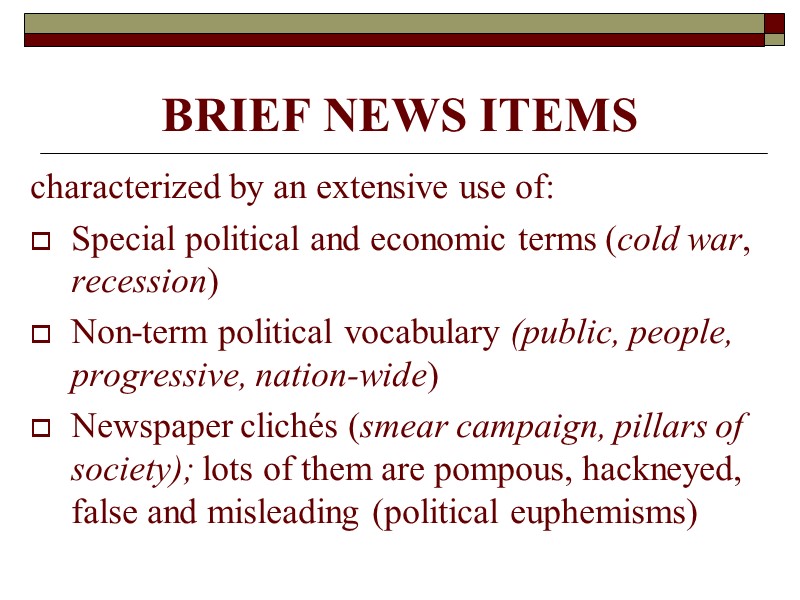
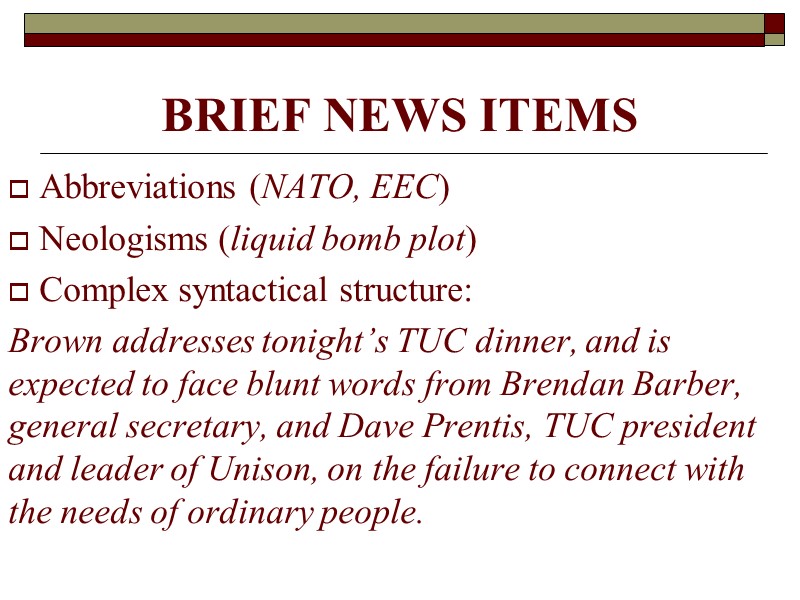
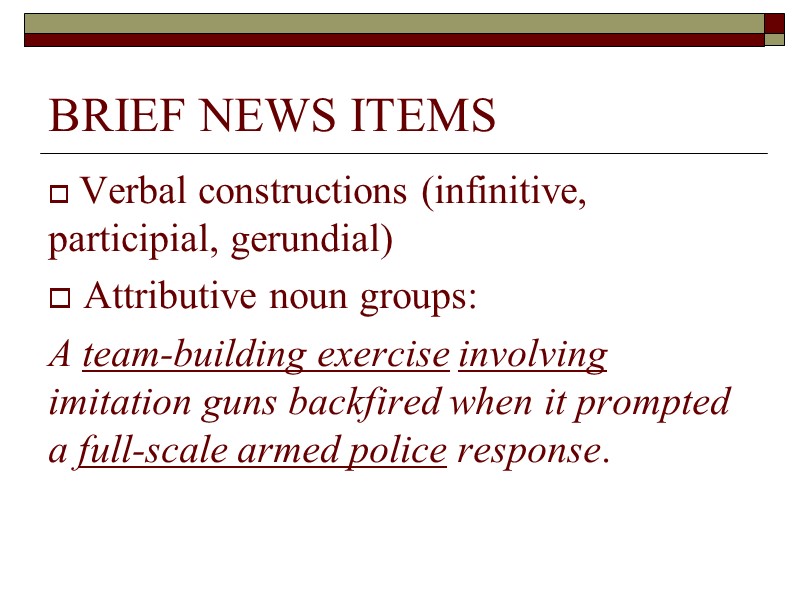
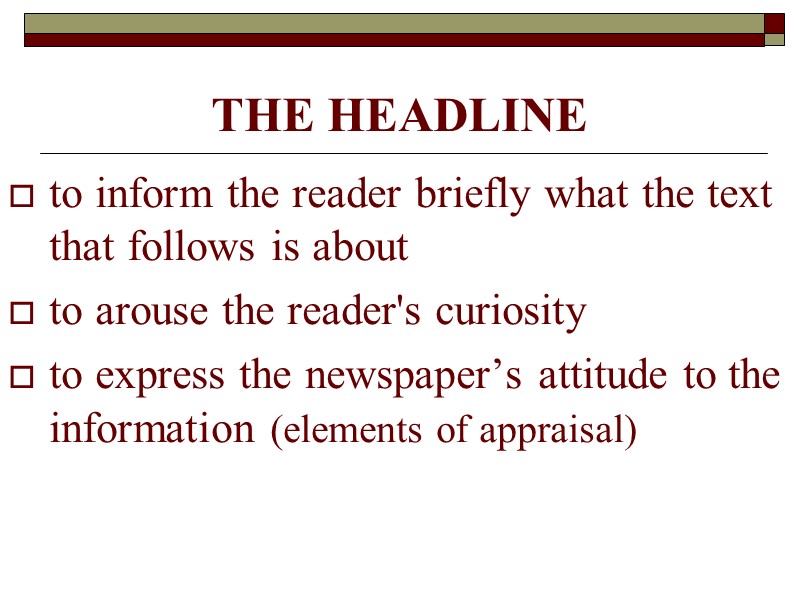
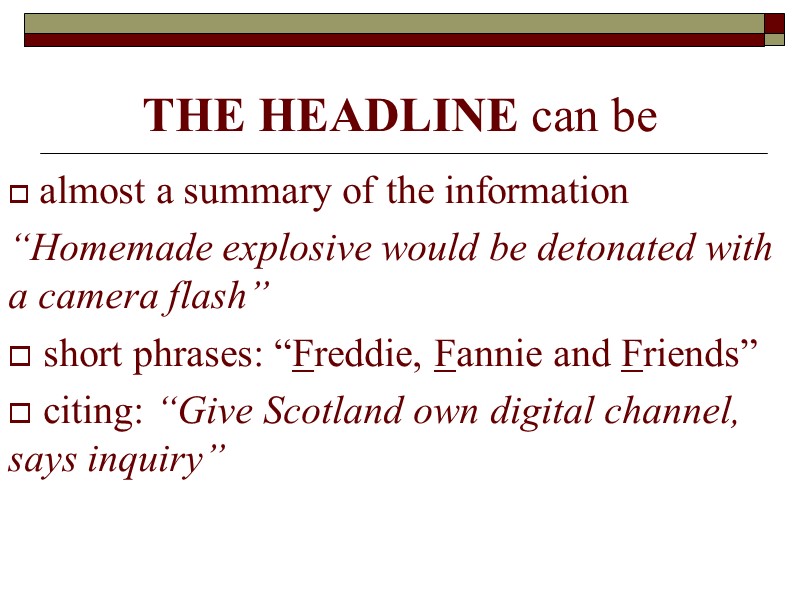
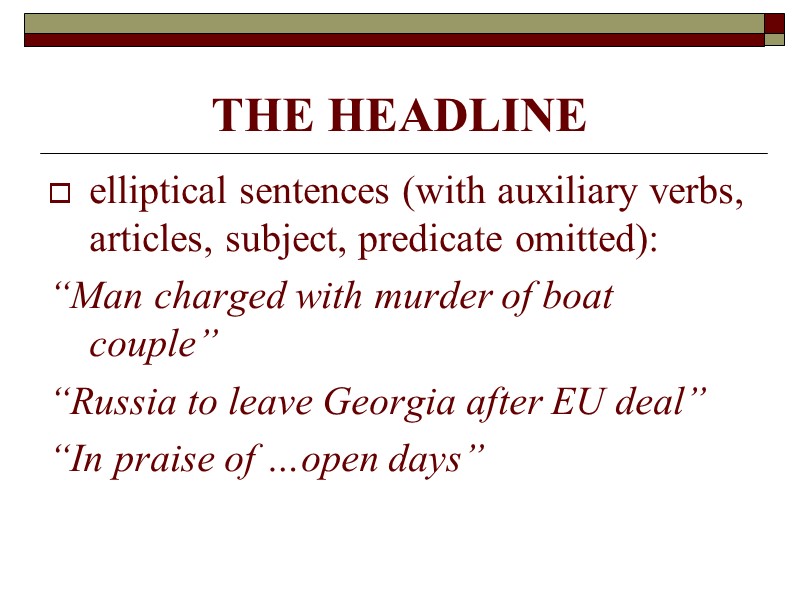
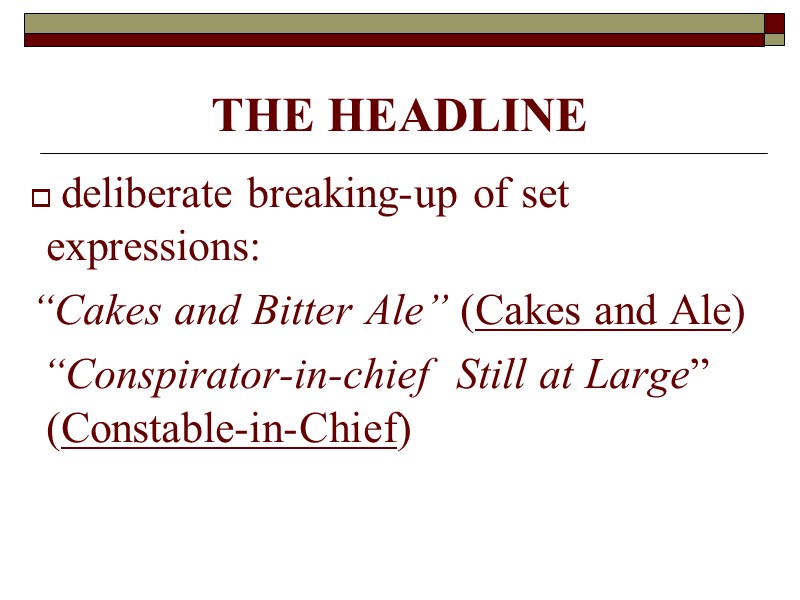
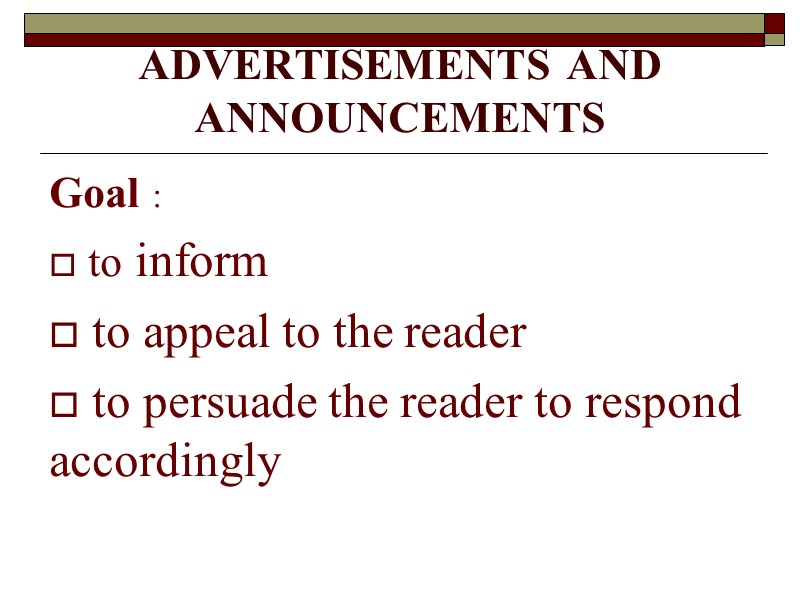
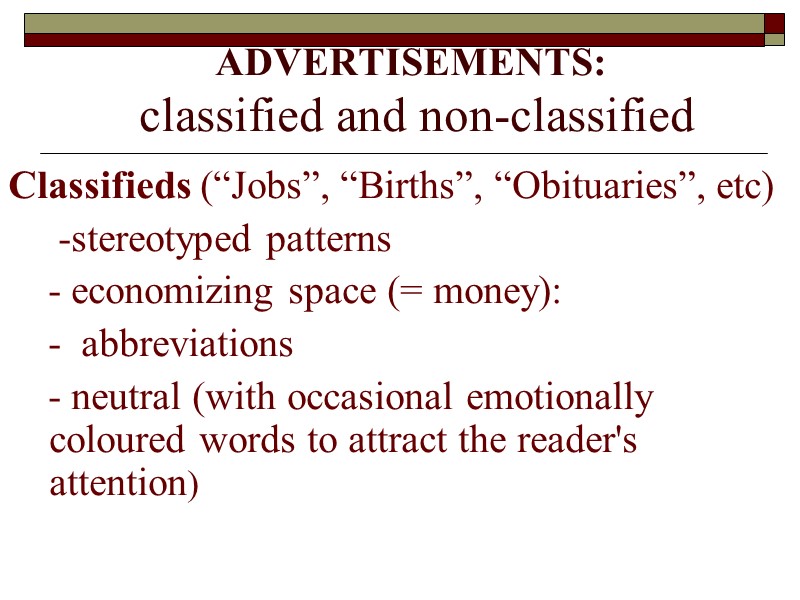
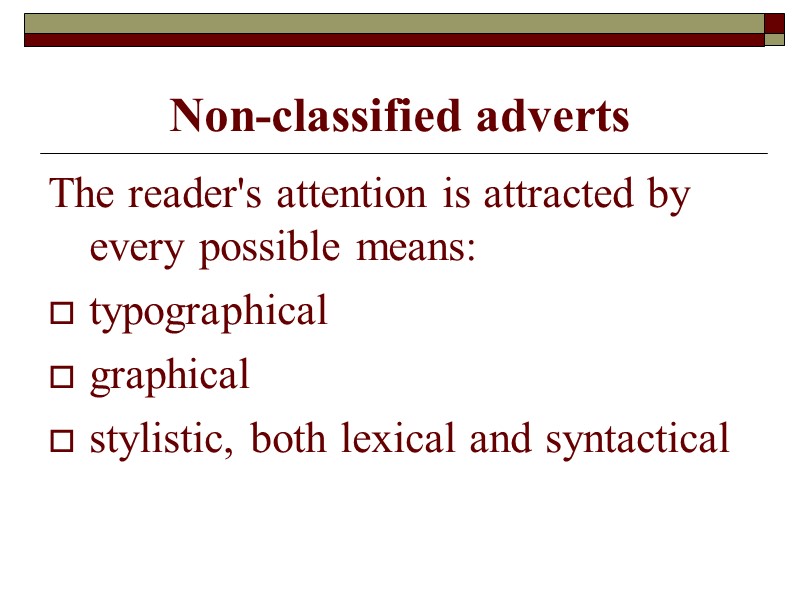
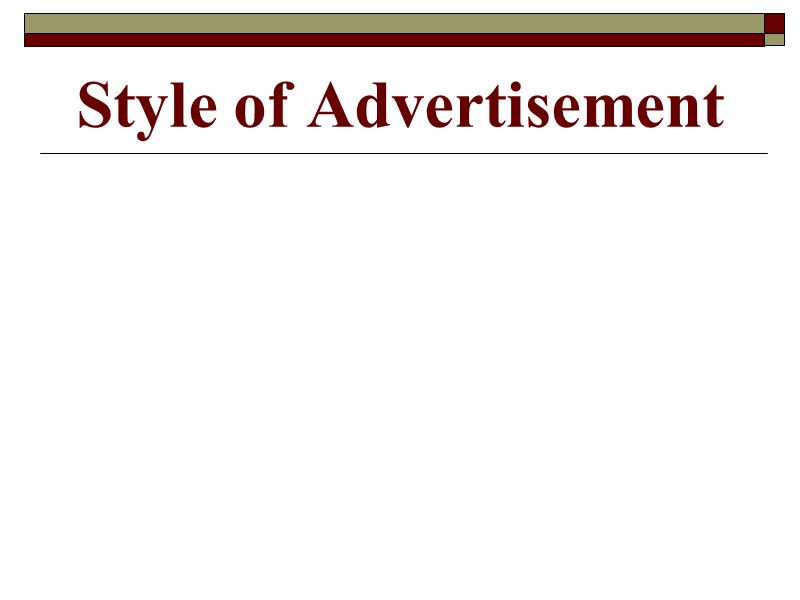
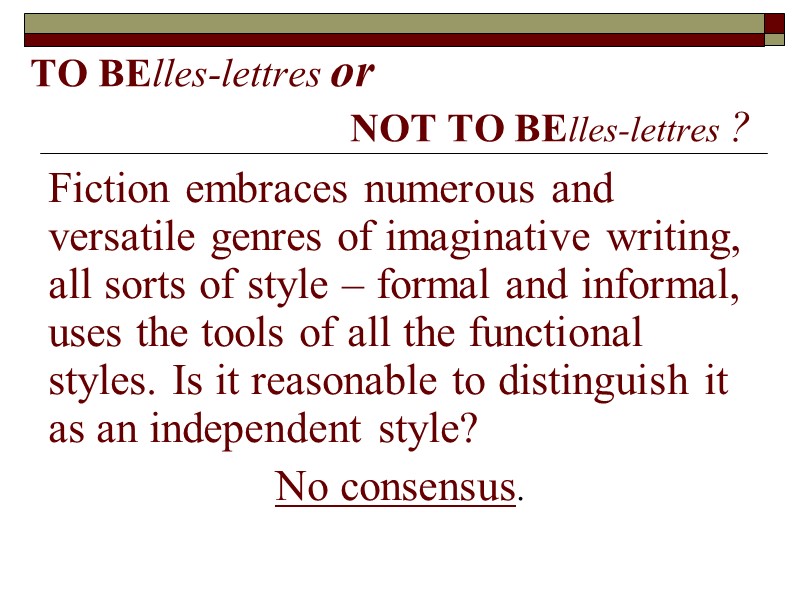
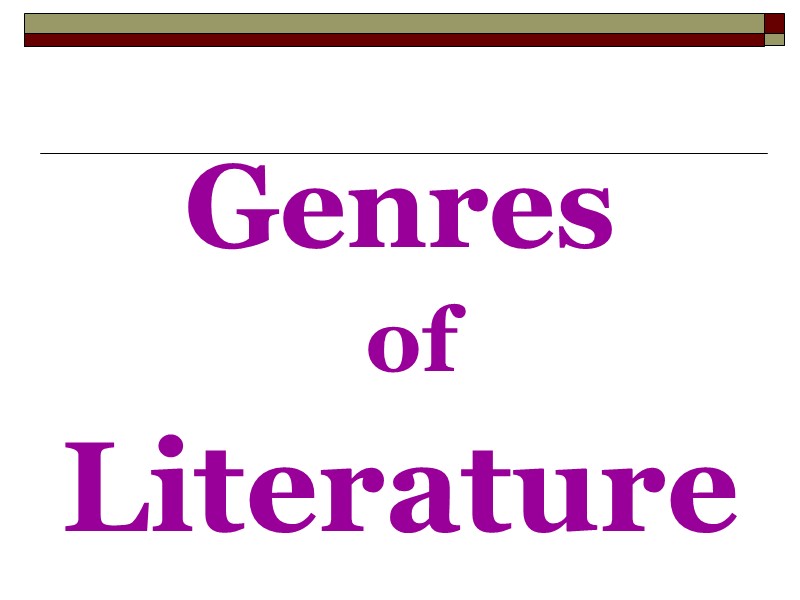
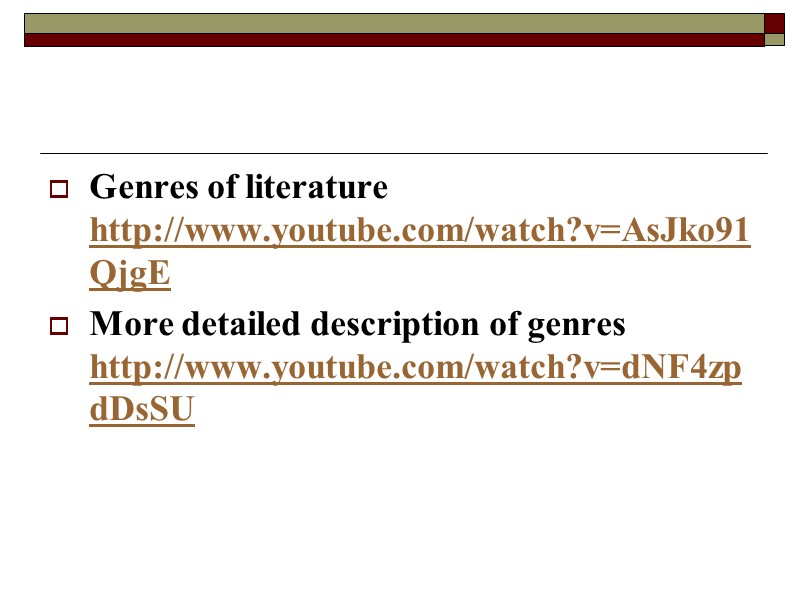
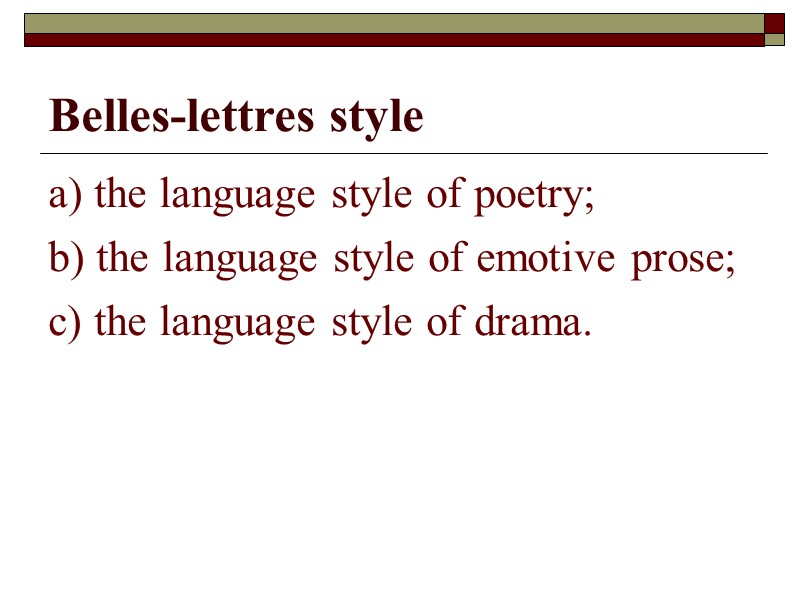
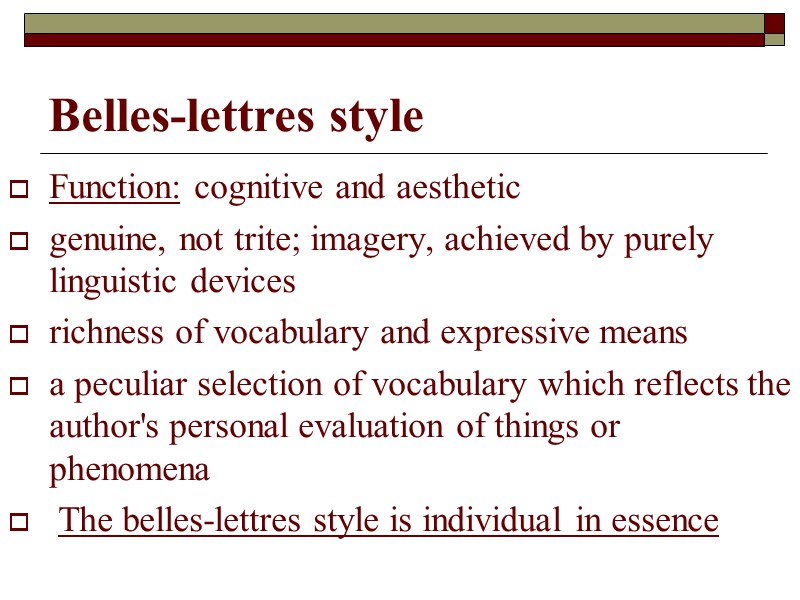

40906-l1_functional_styles.ppt
- Количество слайдов: 83
 Functional styles What is style? What is functional style? Classification of functional styles
Functional styles What is style? What is functional style? Classification of functional styles
 Style (Latin 'stylus‘) "Style is a contextually restricted linguistic variation." (N.E. Enkvist)
Style (Latin 'stylus‘) "Style is a contextually restricted linguistic variation." (N.E. Enkvist)
 Style "Style is a product of individual choices and patterns of choices (emphasis added) among linguistic possibilities." (Seymour Chatman)
Style "Style is a product of individual choices and patterns of choices (emphasis added) among linguistic possibilities." (Seymour Chatman)
 Style "Style is a quality of language which communicates precisely emotions or thoughts, or a system of emotions or thoughts, peculiar to the author.“ (J. M. Murry)
Style "Style is a quality of language which communicates precisely emotions or thoughts, or a system of emotions or thoughts, peculiar to the author.“ (J. M. Murry)
 Style is a set of characteristics by which we distinguish one author from another or members of one subclass from members of other subclasses, all of which are members of the same general class (I.R. Galperin)
Style is a set of characteristics by which we distinguish one author from another or members of one subclass from members of other subclasses, all of which are members of the same general class (I.R. Galperin)
 Style is way of using language By register (circumstances attending the process of speech) : formal –neutral – informal By personal characteristics: Individual style (of a writer) By the context of communication: Functional style
Style is way of using language By register (circumstances attending the process of speech) : formal –neutral – informal By personal characteristics: Individual style (of a writer) By the context of communication: Functional style
 Style is identified by a COMBINATION of properties Lexical means Syntactical means Phonological means style
Style is identified by a COMBINATION of properties Lexical means Syntactical means Phonological means style
 Functional style a system of coordinated, interrelated and interconditioned language means intended to fulfill a specific function of communication and aiming at a definite effect. (I. R. Galperin)
Functional style a system of coordinated, interrelated and interconditioned language means intended to fulfill a specific function of communication and aiming at a definite effect. (I. R. Galperin)
 formal Neutral informal
formal Neutral informal
 Informal Style used in personal two-way every-day communication vocabulary may be determined socially (educational and cultural background, age group, occupation) or regionally (dialect)
Informal Style used in personal two-way every-day communication vocabulary may be determined socially (educational and cultural background, age group, occupation) or regionally (dialect)
 Informal Style gesture, tone, voice are as important as words carelessness in grammar and pronunciation) not much variety in vocabulary (some words are overused: thing, do, get, right, really) repetitions, filling words (you know, kind of, well)
Informal Style gesture, tone, voice are as important as words carelessness in grammar and pronunciation) not much variety in vocabulary (some words are overused: thing, do, get, right, really) repetitions, filling words (you know, kind of, well)
 Informal Style imaginative word play (e.g. These clips are really …clippy) ready-made formulas of politeness and tags (Could you…? Fine, isn’t it?) standard expressions of surprise, gratitude (e.g. Thanks a million), apology (So sorry), etc.
Informal Style imaginative word play (e.g. These clips are really …clippy) ready-made formulas of politeness and tags (Could you…? Fine, isn’t it?) standard expressions of surprise, gratitude (e.g. Thanks a million), apology (So sorry), etc.
 Informal Style lexical expressions of modality (e.g. definitely, in a way, I should think so, not at all, by no means) ellipses (Hope you enjoy it)
Informal Style lexical expressions of modality (e.g. definitely, in a way, I should think so, not at all, by no means) ellipses (Hope you enjoy it)
 Informal Style substantive adjectives (e.g. greens for ’green leaf vegetables’, woolies for ‘woolen clothes’) lexical intensifiers, emphatic verbs and adverbs with lost denotational meaning (e.g. awfully, lovely, terrific, dead right)
Informal Style substantive adjectives (e.g. greens for ’green leaf vegetables’, woolies for ‘woolen clothes’) lexical intensifiers, emphatic verbs and adverbs with lost denotational meaning (e.g. awfully, lovely, terrific, dead right)
 Informal Style Vocabulary Colloquial words - literary colloquial (cultivated speech) - familiar colloquial - low colloquial (illiterate speech) Slang words Dialect words
Informal Style Vocabulary Colloquial words - literary colloquial (cultivated speech) - familiar colloquial - low colloquial (illiterate speech) Slang words Dialect words
 Literary Colloquial used by educated people in an informal conversation or when writing letters to intimate friends bite, snack = meal to have a crush on smb = to fall in love with smb to turn up = come,
Literary Colloquial used by educated people in an informal conversation or when writing letters to intimate friends bite, snack = meal to have a crush on smb = to fall in love with smb to turn up = come,
 Familiar Colloquial more emotional, much more free and careless used mostly by young and semi-educated a great number of jocular or ironical expressions and nonce-words e.g. doc – doctor, ta-ta – good-bye
Familiar Colloquial more emotional, much more free and careless used mostly by young and semi-educated a great number of jocular or ironical expressions and nonce-words e.g. doc – doctor, ta-ta – good-bye
 Low Colloquial Speech illiterate speech contains more vulgar, harsh words (bloody, hell, f-word) sometimes contains elements of dialect
Low Colloquial Speech illiterate speech contains more vulgar, harsh words (bloody, hell, f-word) sometimes contains elements of dialect
 Slang mainly used by young and uneducated characterized by the use of expressive, mostly ironical words which create fresh names for some usual things
Slang mainly used by young and uneducated characterized by the use of expressive, mostly ironical words which create fresh names for some usual things
 Slang most slang words are metaphors and jocular, often with a coarse, mocking, cynical colouring money – beans, bras, dibs, dough, wads drunk – boozy, cock-eyed, soaked
Slang most slang words are metaphors and jocular, often with a coarse, mocking, cynical colouring money – beans, bras, dibs, dough, wads drunk – boozy, cock-eyed, soaked
 Slang slang words and idioms are short-lived, soon they ether disappear or lose their peculiar colouring and become either colloquial or stylistically neutral: chap, fun, mob, shabby, hitch-hiker, once in a blue moon
Slang slang words and idioms are short-lived, soon they ether disappear or lose their peculiar colouring and become either colloquial or stylistically neutral: chap, fun, mob, shabby, hitch-hiker, once in a blue moon
 Slang general slang – for any social or professional group (cool) special slang – peculiar for specific groups: teenager slang, football slang, computer slang: keel = kill (Internet-slang)
Slang general slang – for any social or professional group (cool) special slang – peculiar for specific groups: teenager slang, football slang, computer slang: keel = kill (Internet-slang)
 Argot special vocabulary used by a particular social or age group, the so-called underworld (the criminal circles) its main purpose - to be unintelligible to the outsiders e.g. shin – knife, book – life sentence
Argot special vocabulary used by a particular social or age group, the so-called underworld (the criminal circles) its main purpose - to be unintelligible to the outsiders e.g. shin – knife, book – life sentence
 Dialect Words Dialect is a variety of a language which prevails in a district, with local peculiarities of vocabulary, pronunciation and grammar Allus = always (Yorkshire) Bonkkle = bottle (Birmingham)
Dialect Words Dialect is a variety of a language which prevails in a district, with local peculiarities of vocabulary, pronunciation and grammar Allus = always (Yorkshire) Bonkkle = bottle (Birmingham)
 Dialect Words dialect words may enter colloquial speech, slang, then neutral vocabulary and formal language car, tram, trolley
Dialect Words dialect words may enter colloquial speech, slang, then neutral vocabulary and formal language car, tram, trolley
 Formal Style used in scientific discourse, in monologue, often prepared in advance words are used with precision the vocabulary and syntax are elaborate and standard-oriented
Formal Style used in scientific discourse, in monologue, often prepared in advance words are used with precision the vocabulary and syntax are elaborate and standard-oriented
![>Formal Style Vocabulary Literary / learned words [lə:nid] >Formal Style Vocabulary Literary / learned words [lə:nid]](https://present5.com/presentacii-2/20171213\40906-l1_functional_styles.ppt\40906-l1_functional_styles_27.jpg) Formal Style Vocabulary Literary / learned words [lə:nid] - words of scientific prose - official words - poetic diction archaic and obsolete words professional terminology
Formal Style Vocabulary Literary / learned words [lə:nid] - words of scientific prose - official words - poetic diction archaic and obsolete words professional terminology
 Formal Style Vocabulary literary / learned words – used in descriptive passages of fiction mostly polysyllabic words create complex and solemn associations delusion, reverberate, splenetic, insiduous
Formal Style Vocabulary literary / learned words – used in descriptive passages of fiction mostly polysyllabic words create complex and solemn associations delusion, reverberate, splenetic, insiduous
 Formal Style Vocabulary words of scientific prose experimental, divergent, in terms of, heterogeneous, officialese (канцеляризмы) –bureaucratic language, peculiar to official documents: accommodation (room), donation (gift), comestibles (food), dispatch (send off)
Formal Style Vocabulary words of scientific prose experimental, divergent, in terms of, heterogeneous, officialese (канцеляризмы) –bureaucratic language, peculiar to official documents: accommodation (room), donation (gift), comestibles (food), dispatch (send off)
 Formal Style Vocabulary words of poetic diction: used in poetry characterized by a lofty, high-flown, sometimes archaic colouring they are more abstract e.g. array (clothes), steed (horse), lone (lonely), naught (nothing), thee (you)
Formal Style Vocabulary words of poetic diction: used in poetry characterized by a lofty, high-flown, sometimes archaic colouring they are more abstract e.g. array (clothes), steed (horse), lone (lonely), naught (nothing), thee (you)
 Formal Style Vocabulary Obsolete words are words that dropped from the language, no longer in use, for at least a century.
Formal Style Vocabulary Obsolete words are words that dropped from the language, no longer in use, for at least a century.
 Formal Style Vocabulary Archaic words are words which survive in special contexts, current in an earlier time but rare in present usage. associated with poetic diction e.g. aye (yes), nay (no), morn (morning), betwixt (between)
Formal Style Vocabulary Archaic words are words which survive in special contexts, current in an earlier time but rare in present usage. associated with poetic diction e.g. aye (yes), nay (no), morn (morning), betwixt (between)
 Historical words words denoting objects and phenomena which are things of the past and no longer exist they are names for social relations, institutions, objects of material culture of the past
Historical words words denoting objects and phenomena which are things of the past and no longer exist they are names for social relations, institutions, objects of material culture of the past
 Historical words names of ancient transport means, ancient clothes, weapons, musical instruments, etc. crinoline - кринолин musket - мушкет hansom двухколесный экипаж ( с местом для кучера сзади )
Historical words names of ancient transport means, ancient clothes, weapons, musical instruments, etc. crinoline - кринолин musket - мушкет hansom двухколесный экипаж ( с местом для кучера сзади )
 Professional Terminology Term is a word or a word-group which is specifically employed by a particular branch of science, technology, trade or the arts to convey a concept peculiar to this particular activity
Professional Terminology Term is a word or a word-group which is specifically employed by a particular branch of science, technology, trade or the arts to convey a concept peculiar to this particular activity
 Professional Terminology terms should be monosemantic independent of the context have only denotational meaning terms should not have synonyms cardiovascular (сердечно-сосудистый), futures (фьючерсы = фин.), modem
Professional Terminology terms should be monosemantic independent of the context have only denotational meaning terms should not have synonyms cardiovascular (сердечно-сосудистый), futures (фьючерсы = фин.), modem
 Neutral Vocabulary opposed to formal and informal words used in all kinds of situations, independent of the sphere of communication
Neutral Vocabulary opposed to formal and informal words used in all kinds of situations, independent of the sphere of communication
 Neutral words constitute the core of the language corpus, denote objects and phenomena of everyday importance characterized by high frequency e.g. to walk, summer, child, green
Neutral words constitute the core of the language corpus, denote objects and phenomena of everyday importance characterized by high frequency e.g. to walk, summer, child, green

 Functional styles
Functional styles
 Classification of functional styles official style scientific style publicist style newspaper style belles-lettres style (стиль художественной литературы)
Classification of functional styles official style scientific style publicist style newspaper style belles-lettres style (стиль художественной литературы)
 Official style represented in all kinds of official documents and papers: а) the language style of business documents; b) the language style of diplomatic documents; с) the language style of legal documents; d) the language style of military documents
Official style represented in all kinds of official documents and papers: а) the language style of business documents; b) the language style of diplomatic documents; с) the language style of legal documents; d) the language style of military documents
 Official style (“officialese”) The aim is to reach agreement between two contracting parties: - the state and the citizen, - or citizen and citizen; - a society and its members; - two or more enterprises or bodies; - two or more governments (pacts, treaties); - a person in authority and a subordinate, etc. - a board of directors and employees
Official style (“officialese”) The aim is to reach agreement between two contracting parties: - the state and the citizen, - or citizen and citizen; - a society and its members; - two or more enterprises or bodies; - two or more governments (pacts, treaties); - a person in authority and a subordinate, etc. - a board of directors and employees
 Official style special clichés, terms and set expressions (beg to inform you, I second the motion, provisional agenda, the above-mentioned, hereinafter named, hereby, on behalf of, private advisory, etc.)
Official style special clichés, terms and set expressions (beg to inform you, I second the motion, provisional agenda, the above-mentioned, hereinafter named, hereby, on behalf of, private advisory, etc.)
 Diplomatic documents Special terms and phrases: contracting parties, to ratify an agreement, memorandum, pact, persona non grata, principle of non-interference, extra-territorial status, exchange of ambassadors, Member State
Diplomatic documents Special terms and phrases: contracting parties, to ratify an agreement, memorandum, pact, persona non grata, principle of non-interference, extra-territorial status, exchange of ambassadors, Member State
 Legal language extremely formal style abundance of terms including Latin words (habeas corpus) often incomprehensible even to the native speakers
Legal language extremely formal style abundance of terms including Latin words (habeas corpus) often incomprehensible even to the native speakers
 The Boeing Company By-Laws (Устав) Article 1 Section 4: “Except as otherwise required by statute and as set forth below, notice of each annual or special meeting of stockholders shall be given to each stockholder of record entitled to vote at such a meeting not less than thirty nor more than sixty days before the meeting date.”
The Boeing Company By-Laws (Устав) Article 1 Section 4: “Except as otherwise required by statute and as set forth below, notice of each annual or special meeting of stockholders shall be given to each stockholder of record entitled to vote at such a meeting not less than thirty nor more than sixty days before the meeting date.”
 Official style use of abbreviations, conventional symbols and contractions: Business: oc (over-the counter) без посредников TC (till cancelled) пока не аннулировано, AAAA –American Association of Advertising Agencies (Американская Ассоциация Рекламных Агентств) Military: adv. (advance); atk (attack); obj. (object); ATAS (Air Transport Auxiliary Service),
Official style use of abbreviations, conventional symbols and contractions: Business: oc (over-the counter) без посредников TC (till cancelled) пока не аннулировано, AAAA –American Association of Advertising Agencies (Американская Ассоциация Рекламных Агентств) Military: adv. (advance); atk (attack); obj. (object); ATAS (Air Transport Auxiliary Service),
 Official style fixed compositional patterns Business letters the heading giving (the address of the writer, the date, the name of the addressee and his address) Introduction (Dear Sir(s) / Madam Text Conclusion (Sincerely / Faithfully yours) Signature and work position
Official style fixed compositional patterns Business letters the heading giving (the address of the writer, the date, the name of the addressee and his address) Introduction (Dear Sir(s) / Madam Text Conclusion (Sincerely / Faithfully yours) Signature and work position
 Official style Almost every official document has its own compositional design. Pacts, statutes, contracts, affiliation contracts (трудовой договор / членства), orders (заказы) and minutes (протокол собрания) and memoranda (memos) — all have more or less definite forms.
Official style Almost every official document has its own compositional design. Pacts, statutes, contracts, affiliation contracts (трудовой договор / членства), orders (заказы) and minutes (протокол собрания) and memoranda (memos) — all have more or less definite forms.
 Scientific style found in scientific research papers, dissertations, articles, brochures, monographs and other academic publications а) the language style of arts b) the language style of sciences; с) the language style of popular scientific prose
Scientific style found in scientific research papers, dissertations, articles, brochures, monographs and other academic publications а) the language style of arts b) the language style of sciences; с) the language style of popular scientific prose
 Scientific style the aim is: to prove a hypothesis, to create new concepts, to disclose the internal laws of existence, to establish relations between different phenomena, etc.
Scientific style the aim is: to prove a hypothesis, to create new concepts, to disclose the internal laws of existence, to establish relations between different phenomena, etc.
 Scientific style objective, precise, unemotional, devoid of any individuality generalized language (абстрактный язык) logical sequence of utterances (connectives: as is clear from, therefore, thus, consequently, etc.) use of terms specific to each given branch of science
Scientific style objective, precise, unemotional, devoid of any individuality generalized language (абстрактный язык) logical sequence of utterances (connectives: as is clear from, therefore, thus, consequently, etc.) use of terms specific to each given branch of science
 Scientific style referencing (fооt-nоtes, quotations) impersonality (passive constructions) very prolific in coining new words : - drone (Unmanned Aerial Vehicles) - bionic eye (microchip implanted into the visual cortex of the brain – enables the blind to “see”)
Scientific style referencing (fооt-nоtes, quotations) impersonality (passive constructions) very prolific in coining new words : - drone (Unmanned Aerial Vehicles) - bionic eye (microchip implanted into the visual cortex of the brain – enables the blind to “see”)
 Medical text «Before the individual medical diagnostic and therapeutic procedures are discussed, the conventional approach to management needs to be elucidated». Прежде чем перейти к рассмотрению конкретных диагностических и лечебных мероприятий следует разобрать общепринятый подход к лечению.
Medical text «Before the individual medical diagnostic and therapeutic procedures are discussed, the conventional approach to management needs to be elucidated». Прежде чем перейти к рассмотрению конкретных диагностических и лечебных мероприятий следует разобрать общепринятый подход к лечению.
 Publicist style essay, feature article, most writings of "new journalism", radio and television commentary, public speeches, etc. а) the language style of oratory; b) the language style of essay; с) the language style of feature articles in newspapers and journals.
Publicist style essay, feature article, most writings of "new journalism", radio and television commentary, public speeches, etc. а) the language style of oratory; b) the language style of essay; с) the language style of feature articles in newspapers and journals.
 Style of oratory the oral subdivision of the publicist style purpose of oratory is persuasion requires a lot of eloquence speeches on political and social occasions (party meetings, weddings, funerals, jubilees, in sermons and debates, in speeches of counsel and judges in courts of law)
Style of oratory the oral subdivision of the publicist style purpose of oratory is persuasion requires a lot of eloquence speeches on political and social occasions (party meetings, weddings, funerals, jubilees, in sermons and debates, in speeches of counsel and judges in courts of law)
 Style of oratory direct address to the audience by special formulas (Ladies and Gentlemen) final formulas to thank the audience (Thank you very much; Thank you for your time) use of we, let’s (identifying with the audience)
Style of oratory direct address to the audience by special formulas (Ladies and Gentlemen) final formulas to thank the audience (Thank you very much; Thank you for your time) use of we, let’s (identifying with the audience)
 Style of oratory features of colloquial style (I’ll; won’t; haven’t; isn’t, etc) to reach closer contact; the emotional colouring may be solemn, or ironic, but not “lowered” - jocular, rude, vulgar, or slangy; stylistic devices to rouse the audience and keep it in suspense (repetition, climax, rhetorical questions, parallel constructions, etc.)
Style of oratory features of colloquial style (I’ll; won’t; haven’t; isn’t, etc) to reach closer contact; the emotional colouring may be solemn, or ironic, but not “lowered” - jocular, rude, vulgar, or slangy; stylistic devices to rouse the audience and keep it in suspense (repetition, climax, rhetorical questions, parallel constructions, etc.)
 Style of oratory Skills of public speaking: voice intonation and pausation ability to break the monotony Listen to an example.
Style of oratory Skills of public speaking: voice intonation and pausation ability to break the monotony Listen to an example.
 Essay is a literary composition of moderate length on philosophical, social, scientific or literary subjects preserves a clearly personal character has no pretence to deep or strictly scientific treatment of the subject a number of comments, without any definite conclusions
Essay is a literary composition of moderate length on philosophical, social, scientific or literary subjects preserves a clearly personal character has no pretence to deep or strictly scientific treatment of the subject a number of comments, without any definite conclusions
 Essay brevity of expression; use of the first person singular (a personal approach to the problems treated); an expended use of connectives, which facilitates the process of grasping the correlation of ideas; abundant use of emotive words; use of similes and metaphors as one of the media for the cognitive process.
Essay brevity of expression; use of the first person singular (a personal approach to the problems treated); an expended use of connectives, which facilitates the process of grasping the correlation of ideas; abundant use of emotive words; use of similes and metaphors as one of the media for the cognitive process.
 Newspaper style observed in the majority of information materials printed in newspapers the language style of brief news items the language style of newspaper headlines; the language style of advertisements
Newspaper style observed in the majority of information materials printed in newspapers the language style of brief news items the language style of newspaper headlines; the language style of advertisements
 Publicist style goal - to give ‘views’, i.e. to shape the audience’s opinion, to make the audience accept the speaker’s point of view Newspaper style goal – to give news, i.e. to inform the audience PUBLICIST vs NEWSPAPER STYLE
Publicist style goal - to give ‘views’, i.e. to shape the audience’s opinion, to make the audience accept the speaker’s point of view Newspaper style goal – to give news, i.e. to inform the audience PUBLICIST vs NEWSPAPER STYLE
 Newspaper style Informative, unbiased and evaluative to a certain extent specific vocabulary to avoid direct responsibility: The minister is reported to have denied the fact The President was quoted as saying that there was no reason for panic.
Newspaper style Informative, unbiased and evaluative to a certain extent specific vocabulary to avoid direct responsibility: The minister is reported to have denied the fact The President was quoted as saying that there was no reason for panic.
 BRIEF NEWS ITEMS state facts without giving explicit comments mostly implicit evaluation stylistically neutral, unemotional matter-of-fact and stereotyped forms neutral and common literary vocabulary
BRIEF NEWS ITEMS state facts without giving explicit comments mostly implicit evaluation stylistically neutral, unemotional matter-of-fact and stereotyped forms neutral and common literary vocabulary
 BRIEF NEWS ITEMS characterized by an extensive use of: Special political and economic terms (cold war, recession) Non-term political vocabulary (public, people, progressive, nation-wide) Newspaper clichés (smear campaign, pillars of society); lots of them are pompous, hackneyed, false and misleading (political euphemisms)
BRIEF NEWS ITEMS characterized by an extensive use of: Special political and economic terms (cold war, recession) Non-term political vocabulary (public, people, progressive, nation-wide) Newspaper clichés (smear campaign, pillars of society); lots of them are pompous, hackneyed, false and misleading (political euphemisms)
 BRIEF NEWS ITEMS Abbreviations (NATO, EEC) Neologisms (liquid bomb plot) Complex syntactical structure: Brown addresses tonight’s TUC dinner, and is expected to face blunt words from Brendan Barber, general secretary, and Dave Prentis, TUC president and leader of Unison, on the failure to connect with the needs of ordinary people.
BRIEF NEWS ITEMS Abbreviations (NATO, EEC) Neologisms (liquid bomb plot) Complex syntactical structure: Brown addresses tonight’s TUC dinner, and is expected to face blunt words from Brendan Barber, general secretary, and Dave Prentis, TUC president and leader of Unison, on the failure to connect with the needs of ordinary people.
 BRIEF NEWS ITEMS Verbal constructions (infinitive, participial, gerundial) Attributive noun groups: A team-building exercise involving imitation guns backfired when it prompted a full-scale armed police response.
BRIEF NEWS ITEMS Verbal constructions (infinitive, participial, gerundial) Attributive noun groups: A team-building exercise involving imitation guns backfired when it prompted a full-scale armed police response.
 THE HEADLINE to inform the reader briefly what the text that follows is about to arouse the reader's curiosity to express the newspaper’s attitude to the information (elements of appraisal)
THE HEADLINE to inform the reader briefly what the text that follows is about to arouse the reader's curiosity to express the newspaper’s attitude to the information (elements of appraisal)
 THE HEADLINE can be almost a summary of the information “Homemade explosive would be detonated with a camera flash” short phrases: “Freddie, Fannie and Friends” citing: “Give Scotland own digital channel, says inquiry”
THE HEADLINE can be almost a summary of the information “Homemade explosive would be detonated with a camera flash” short phrases: “Freddie, Fannie and Friends” citing: “Give Scotland own digital channel, says inquiry”
 THE HEADLINE elliptical sentences (with auxiliary verbs, articles, subject, predicate omitted): “Man charged with murder of boat couple” “Russia to leave Georgia after EU deal” “In praise of …open days”
THE HEADLINE elliptical sentences (with auxiliary verbs, articles, subject, predicate omitted): “Man charged with murder of boat couple” “Russia to leave Georgia after EU deal” “In praise of …open days”
 THE HEADLINE deliberate breaking-up of set expressions: “Cakes and Bitter Ale” (Cakes and Ale) “Conspirator-in-chief Still at Large” (Constable-in-Chief)
THE HEADLINE deliberate breaking-up of set expressions: “Cakes and Bitter Ale” (Cakes and Ale) “Conspirator-in-chief Still at Large” (Constable-in-Chief)
 ADVERTISEMENTS AND ANNOUNCEMENTS Goal : to inform to appeal to the reader to persuade the reader to respond accordingly
ADVERTISEMENTS AND ANNOUNCEMENTS Goal : to inform to appeal to the reader to persuade the reader to respond accordingly
 ADVERTISEMENTS: classified and non-classified Classifieds (“Jobs”, “Births”, “Obituaries”, etc) -stereotyped patterns - economizing space (= money): - abbreviations - neutral (with occasional emotionally coloured words to attract the reader's attention)
ADVERTISEMENTS: classified and non-classified Classifieds (“Jobs”, “Births”, “Obituaries”, etc) -stereotyped patterns - economizing space (= money): - abbreviations - neutral (with occasional emotionally coloured words to attract the reader's attention)
 Non-classified adverts The reader's attention is attracted by every possible means: typographical graphical stylistic, both lexical and syntactical
Non-classified adverts The reader's attention is attracted by every possible means: typographical graphical stylistic, both lexical and syntactical
 Style of Advertisement
Style of Advertisement
 TO BElles-lettres or NOT TO BElles-lettres ? Fiction embraces numerous and versatile genres of imaginative writing, all sorts of style – formal and informal, uses the tools of all the functional styles. Is it reasonable to distinguish it as an independent style? No consensus.
TO BElles-lettres or NOT TO BElles-lettres ? Fiction embraces numerous and versatile genres of imaginative writing, all sorts of style – formal and informal, uses the tools of all the functional styles. Is it reasonable to distinguish it as an independent style? No consensus.
 Genres of Literature
Genres of Literature
 Genres of literature http://www.youtube.com/watch?v=AsJko91QjgE More detailed description of genres http://www.youtube.com/watch?v=dNF4zpdDsSU
Genres of literature http://www.youtube.com/watch?v=AsJko91QjgE More detailed description of genres http://www.youtube.com/watch?v=dNF4zpdDsSU
 Belles-lettres style а) the language style of poetry; b) the language style of emotive prose; с) the language style of drama.
Belles-lettres style а) the language style of poetry; b) the language style of emotive prose; с) the language style of drama.
 Belles-lettres style Function: cognitive and aesthetic genuine, not trite; imagery, achieved by purely linguistic devices richness of vocabulary and expressive means a peculiar selection of vocabulary which reflects the author's personal evaluation of things or phenomena The belles-lettres style is individual in essence
Belles-lettres style Function: cognitive and aesthetic genuine, not trite; imagery, achieved by purely linguistic devices richness of vocabulary and expressive means a peculiar selection of vocabulary which reflects the author's personal evaluation of things or phenomena The belles-lettres style is individual in essence


